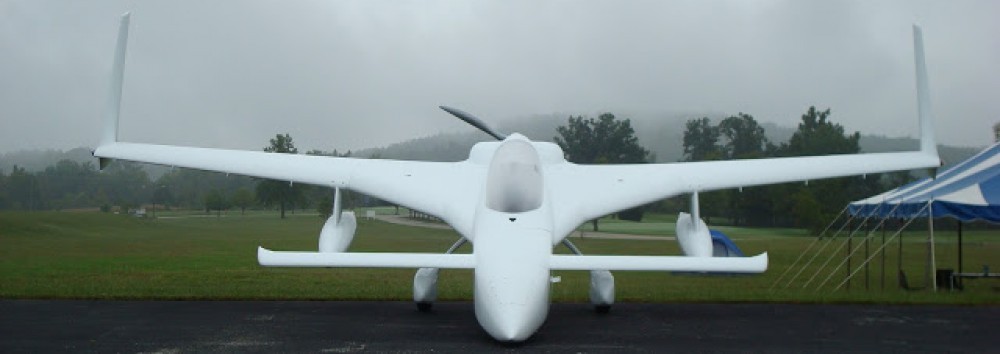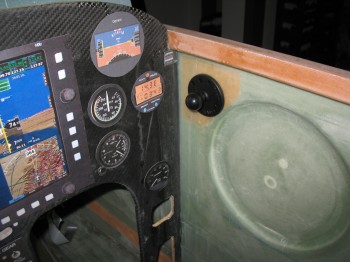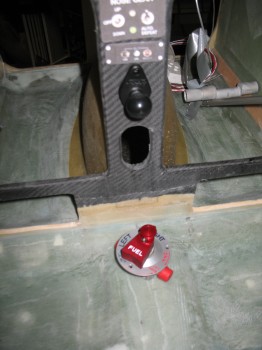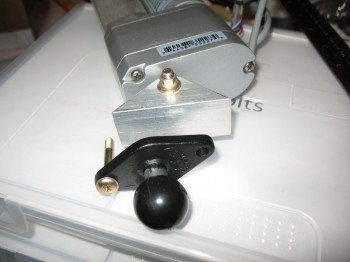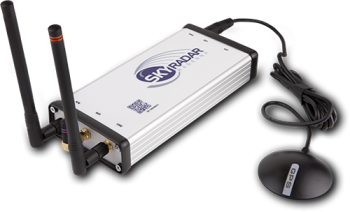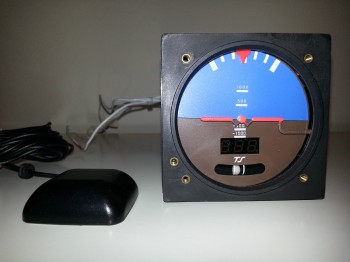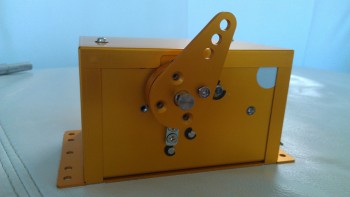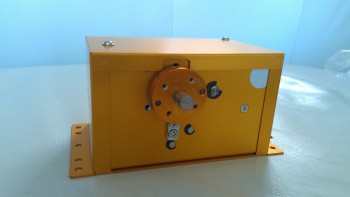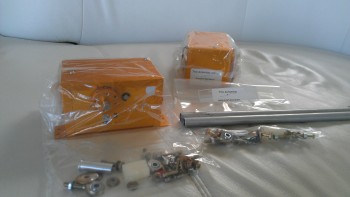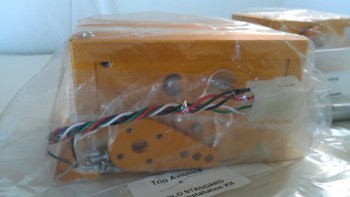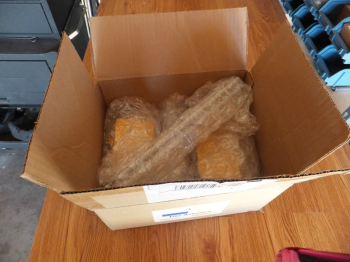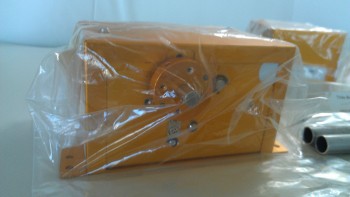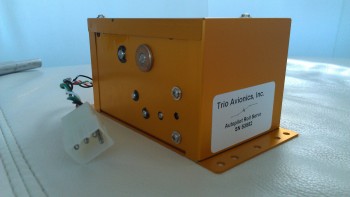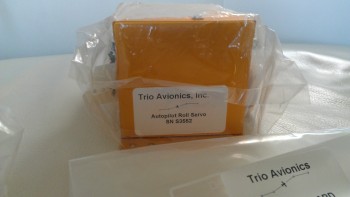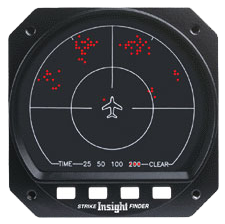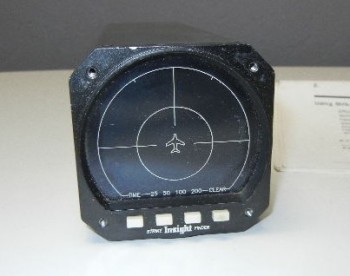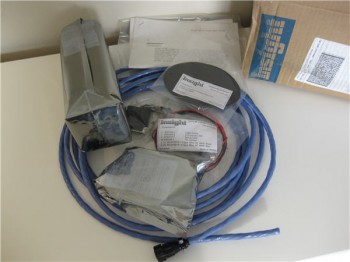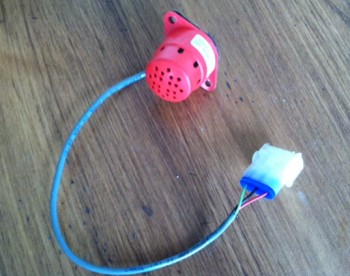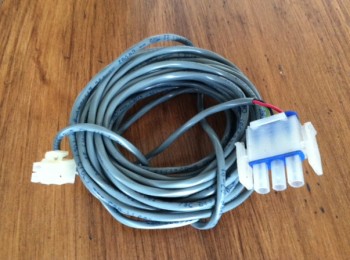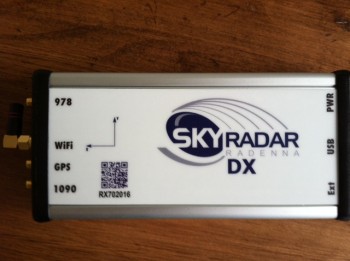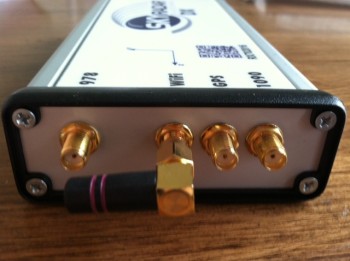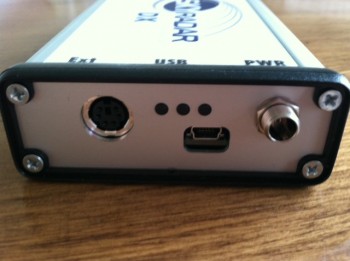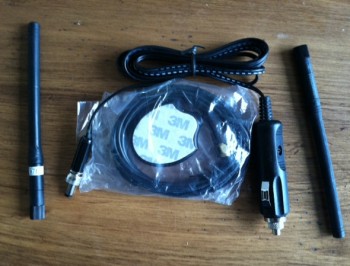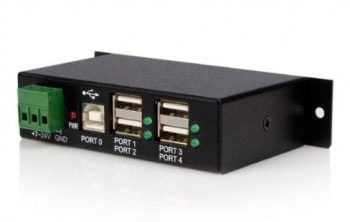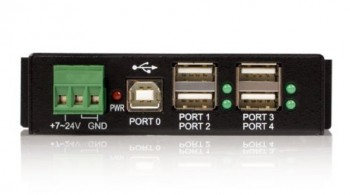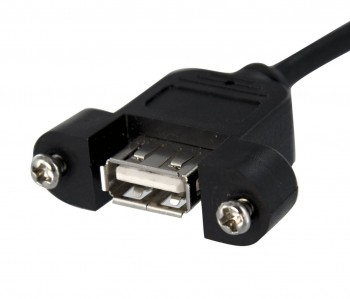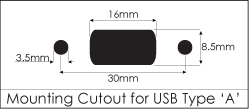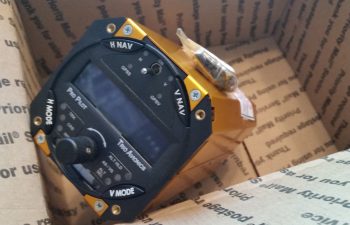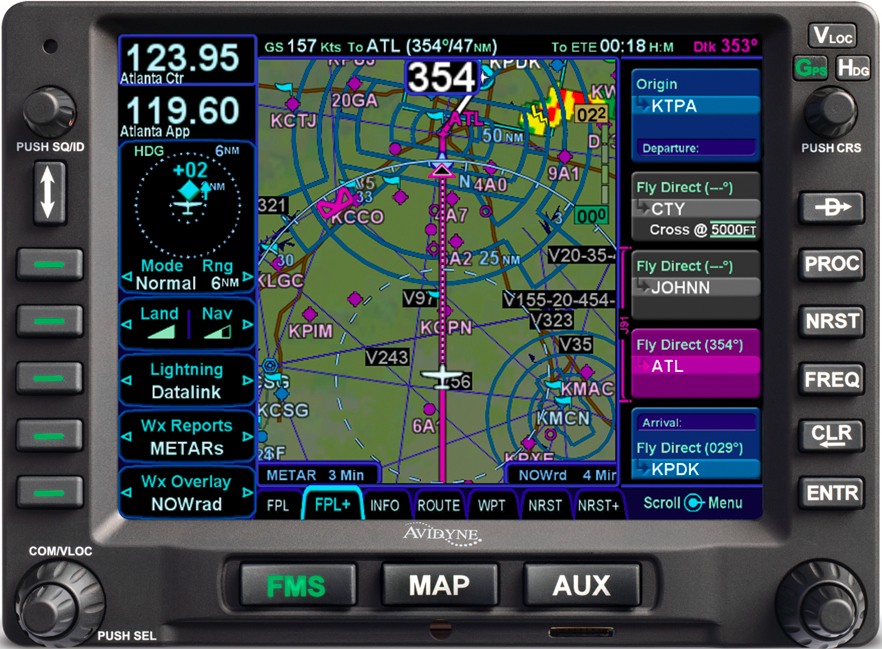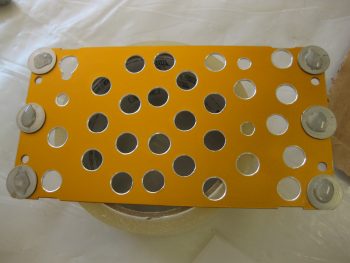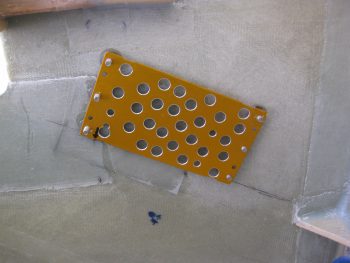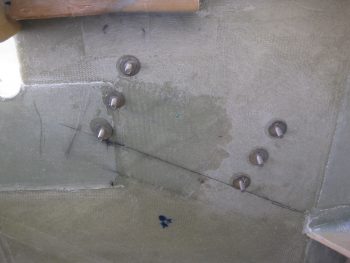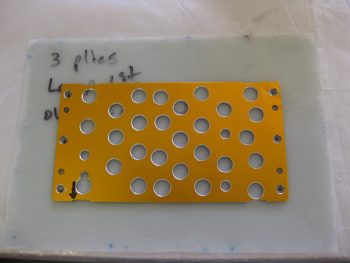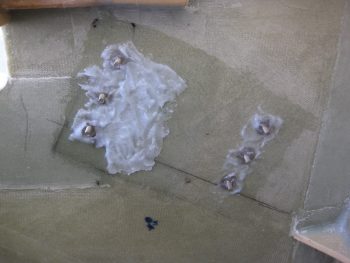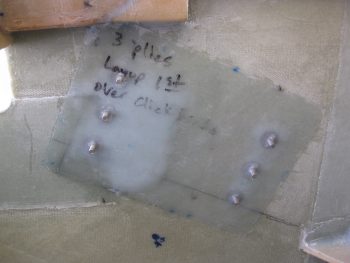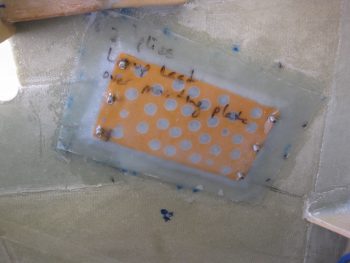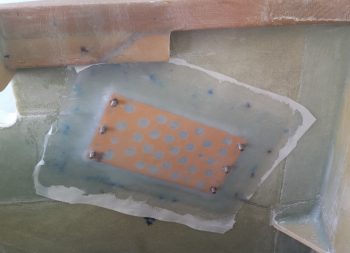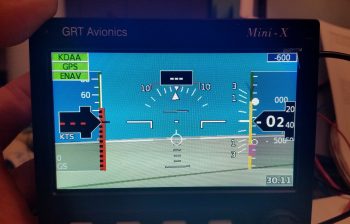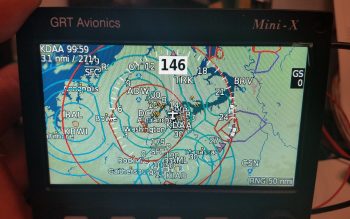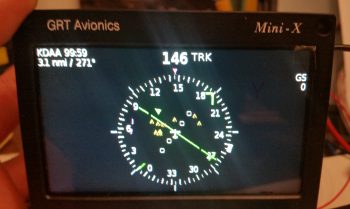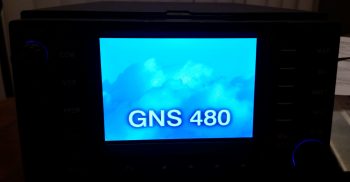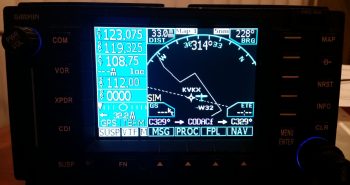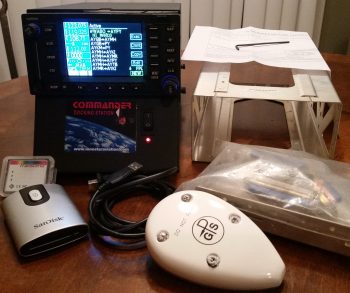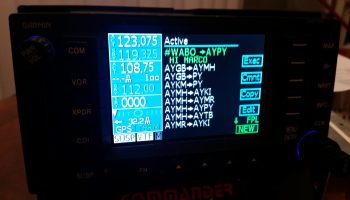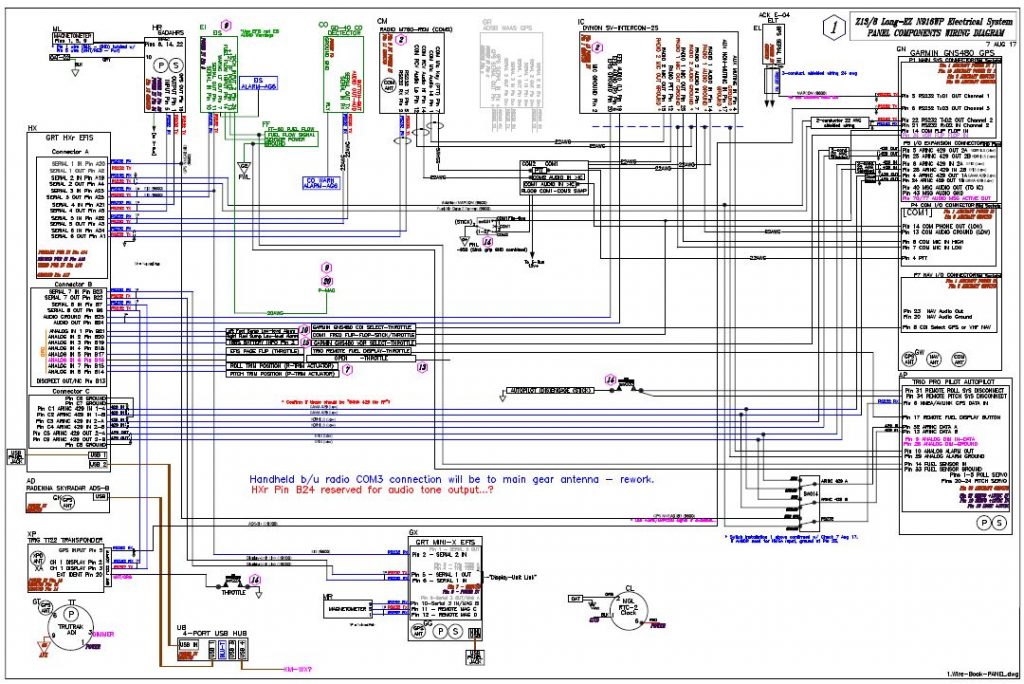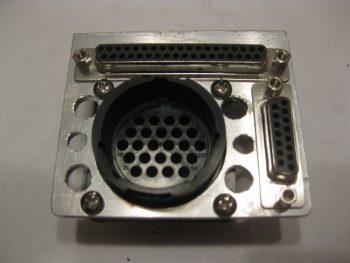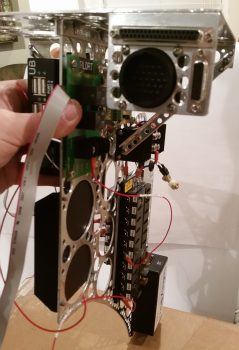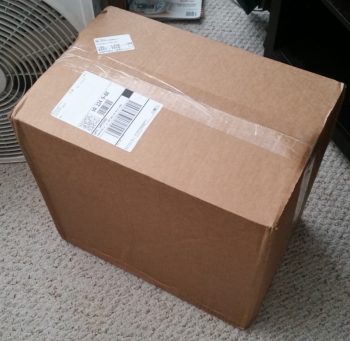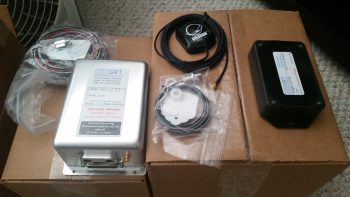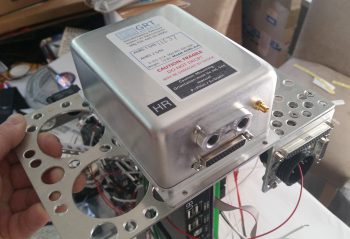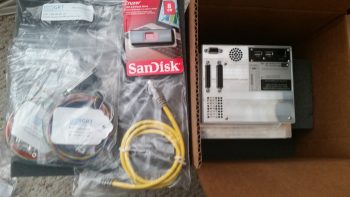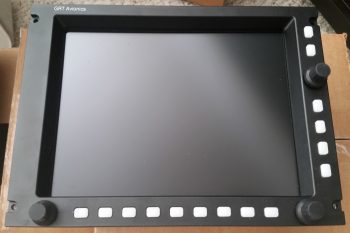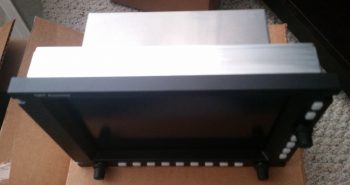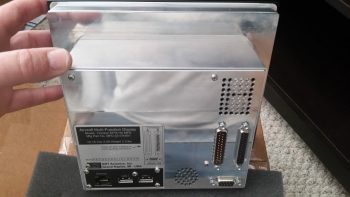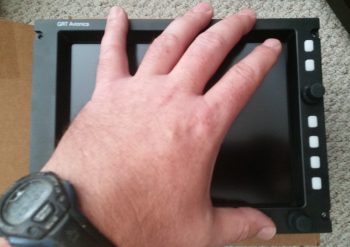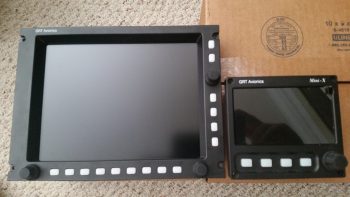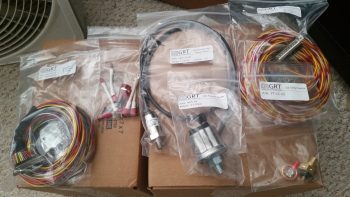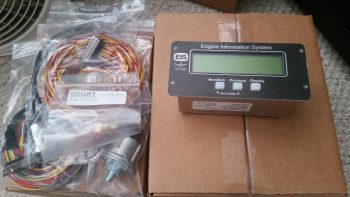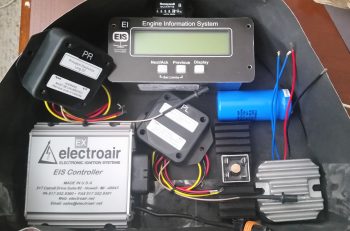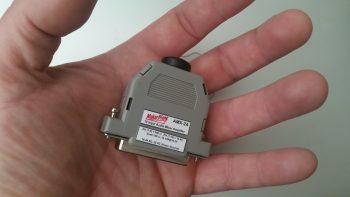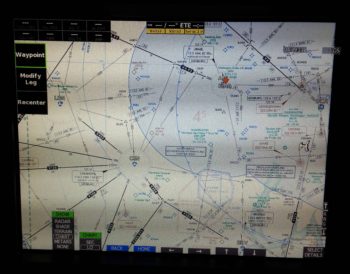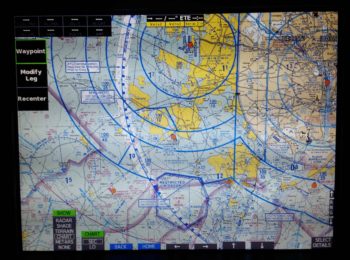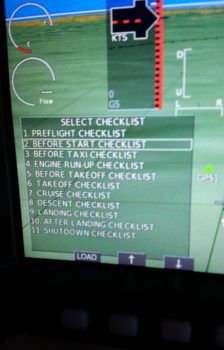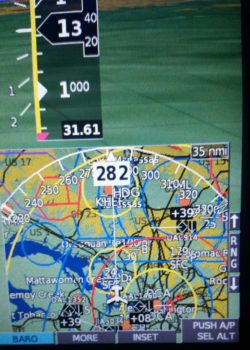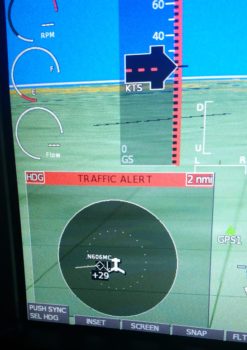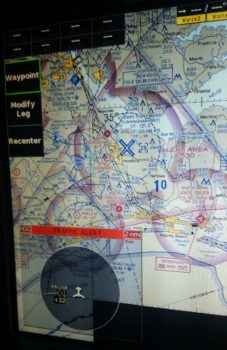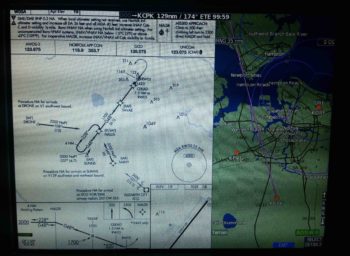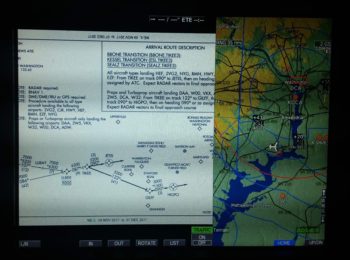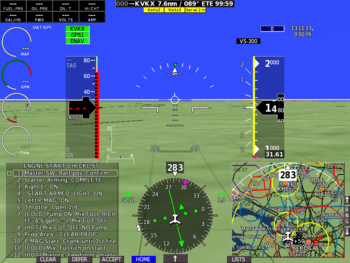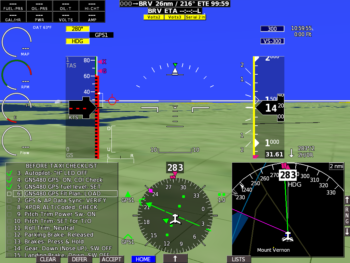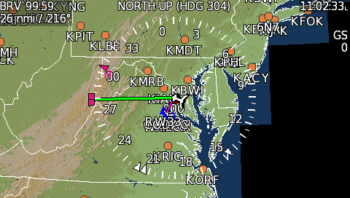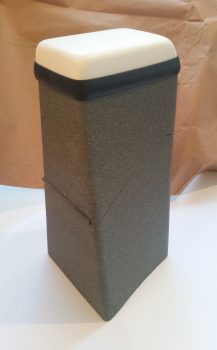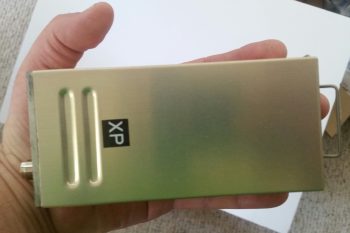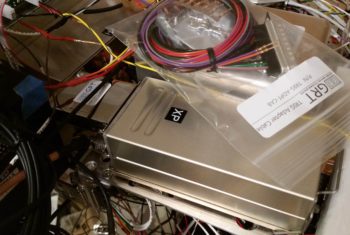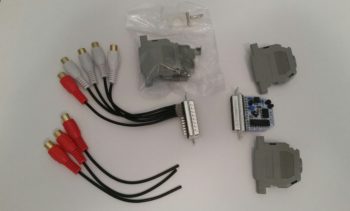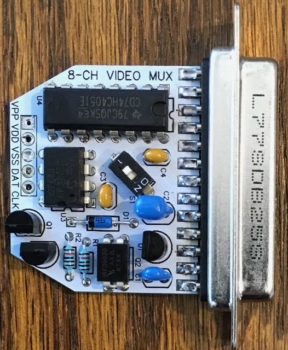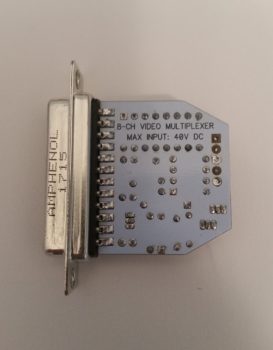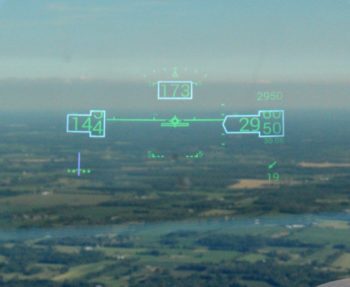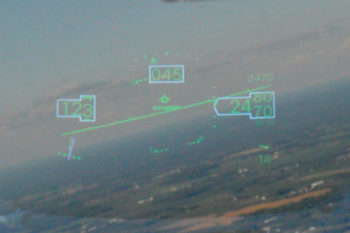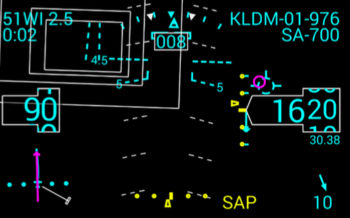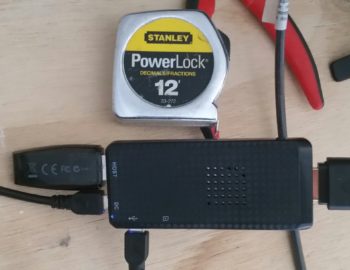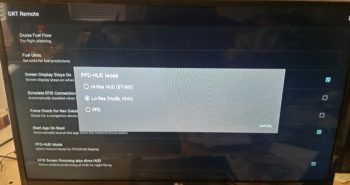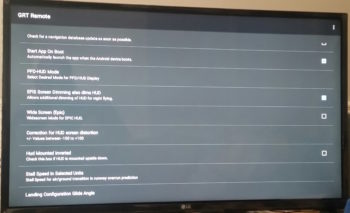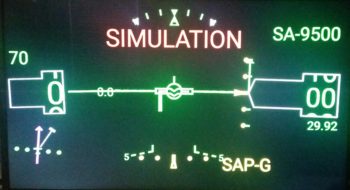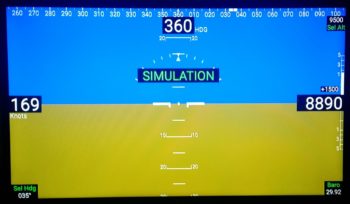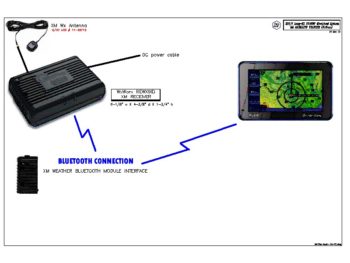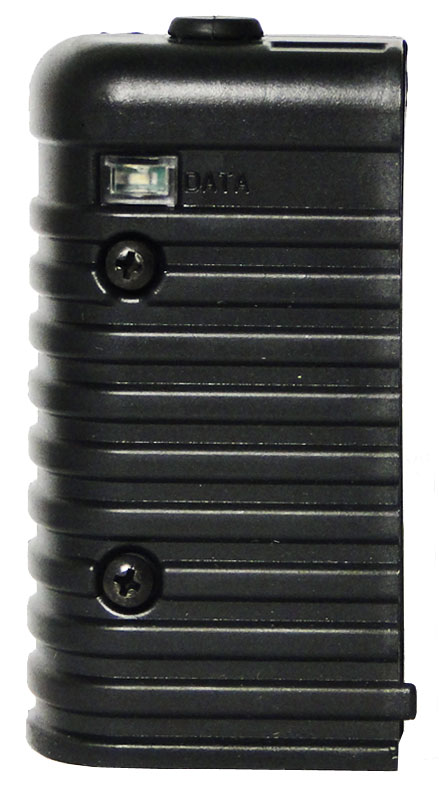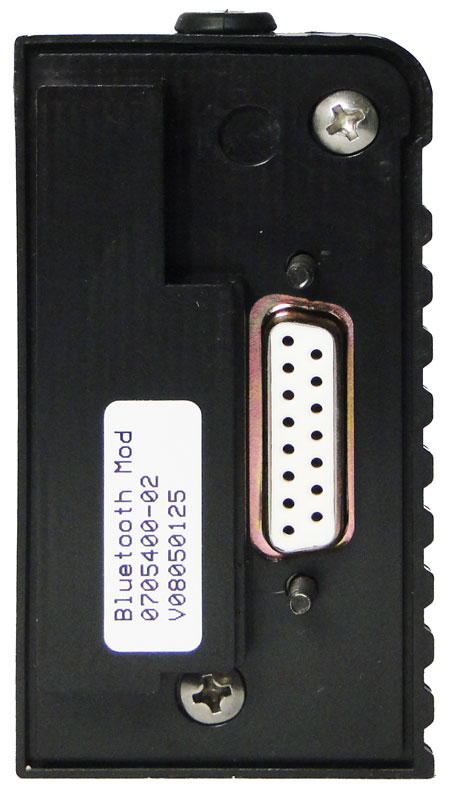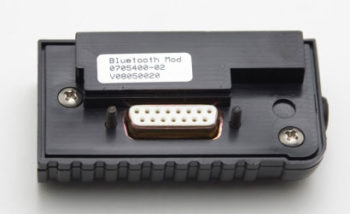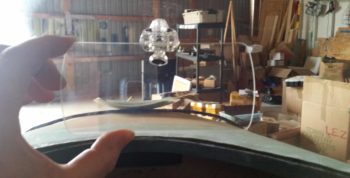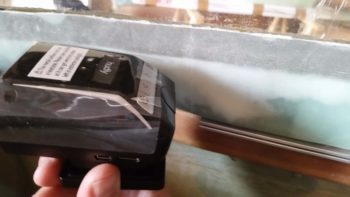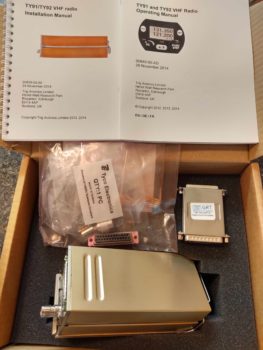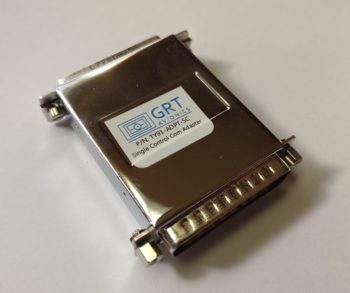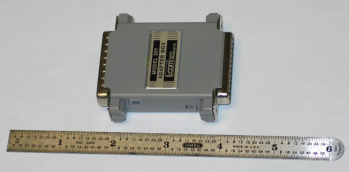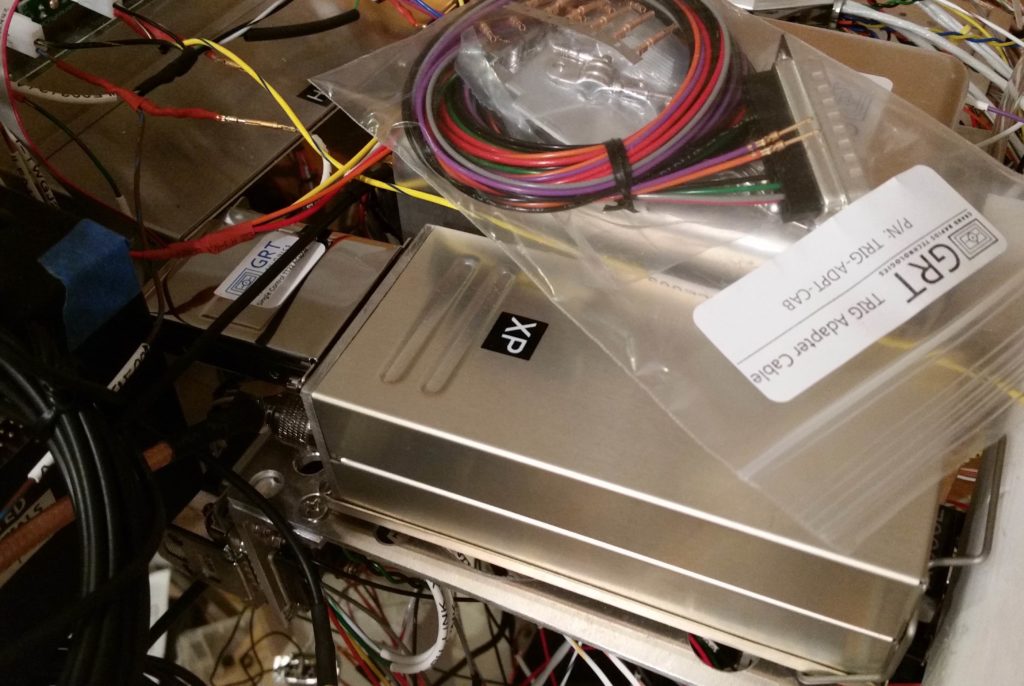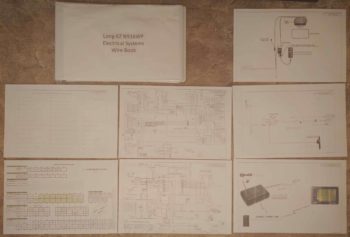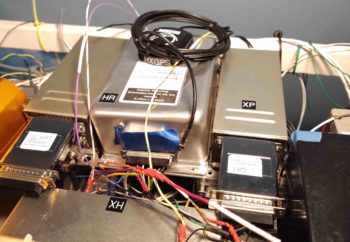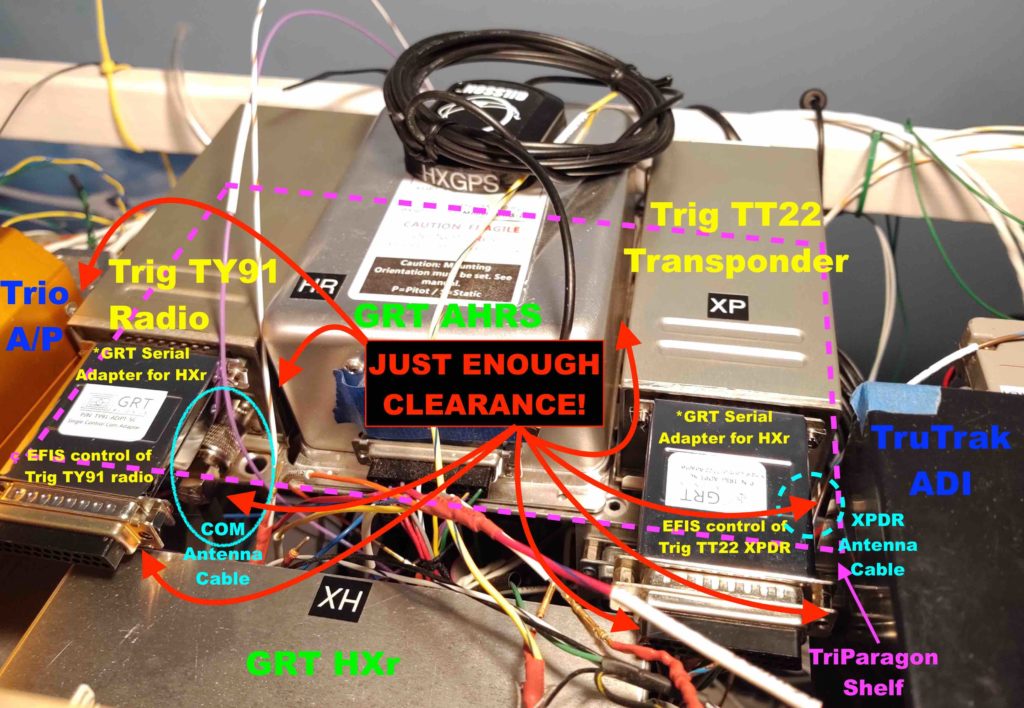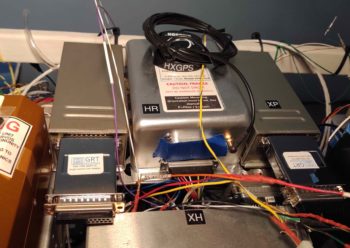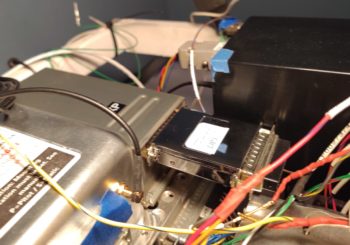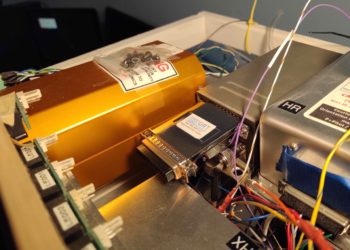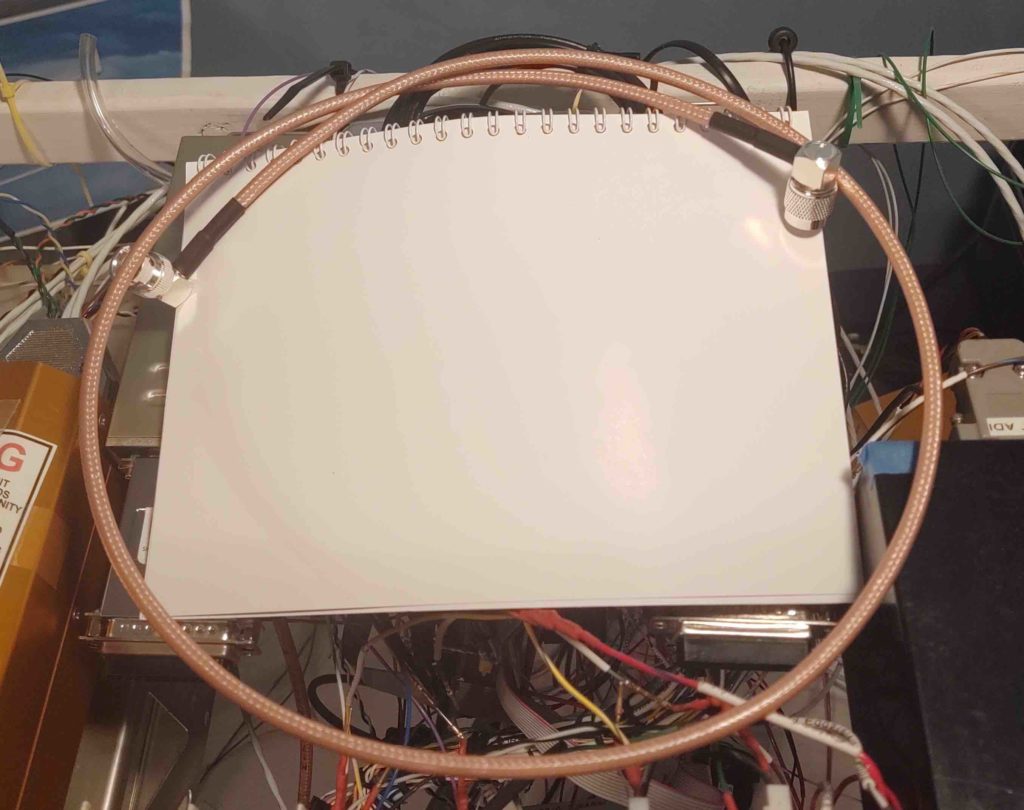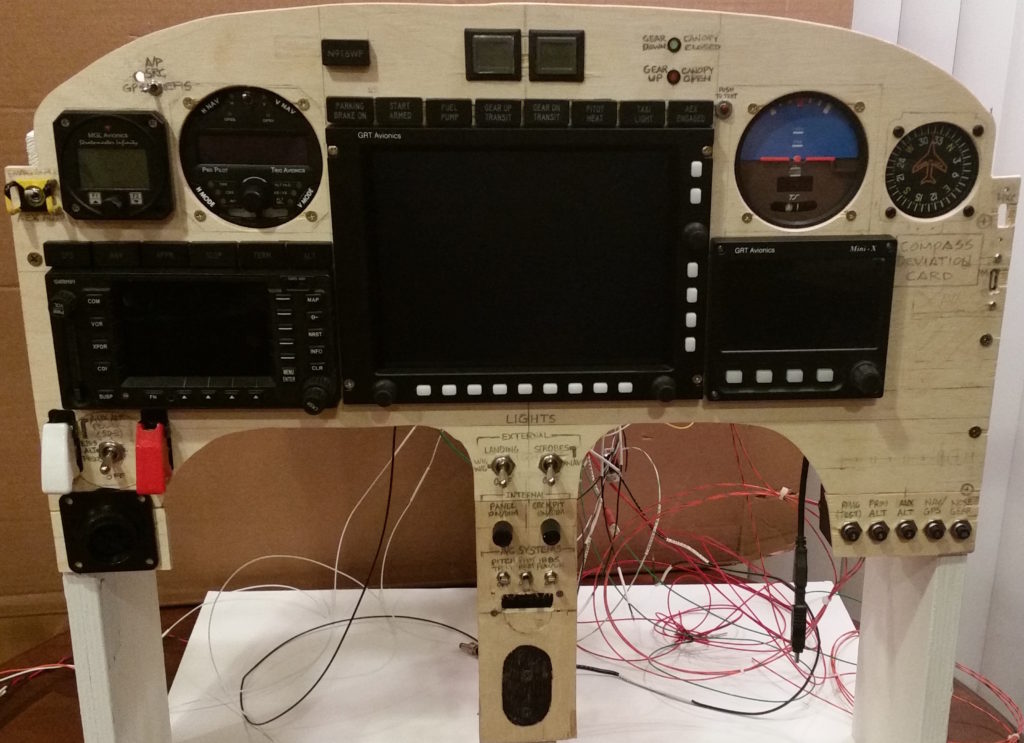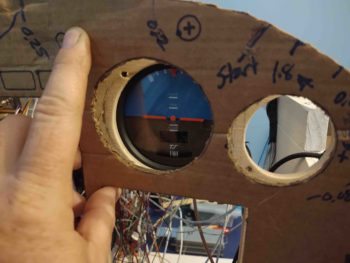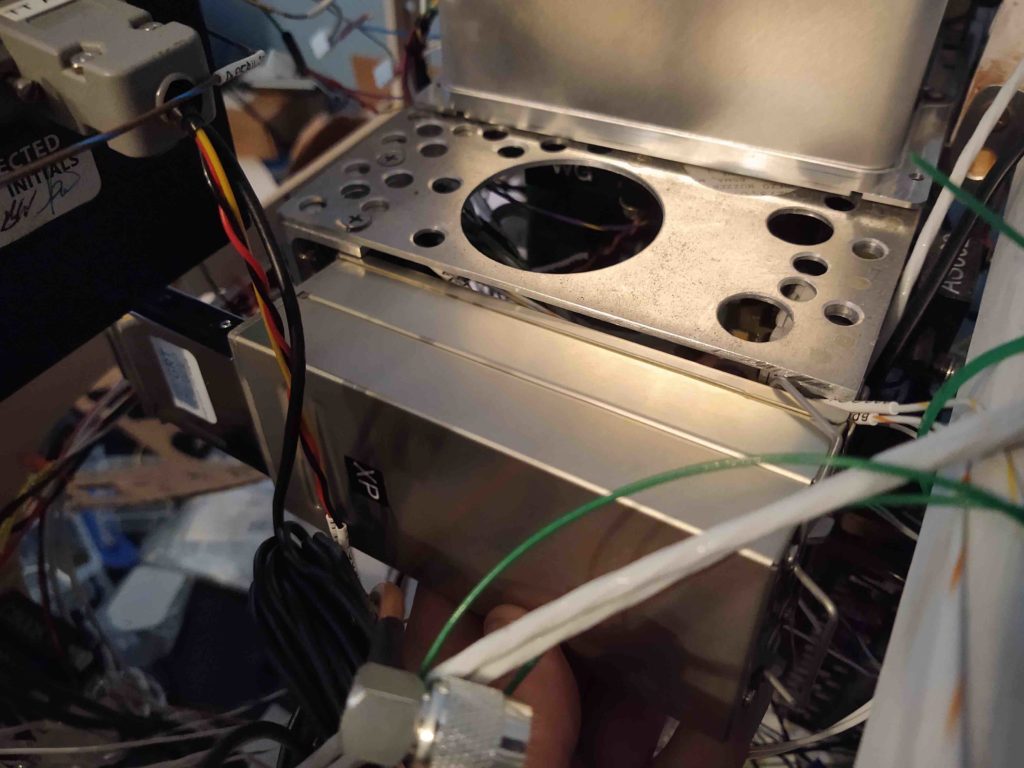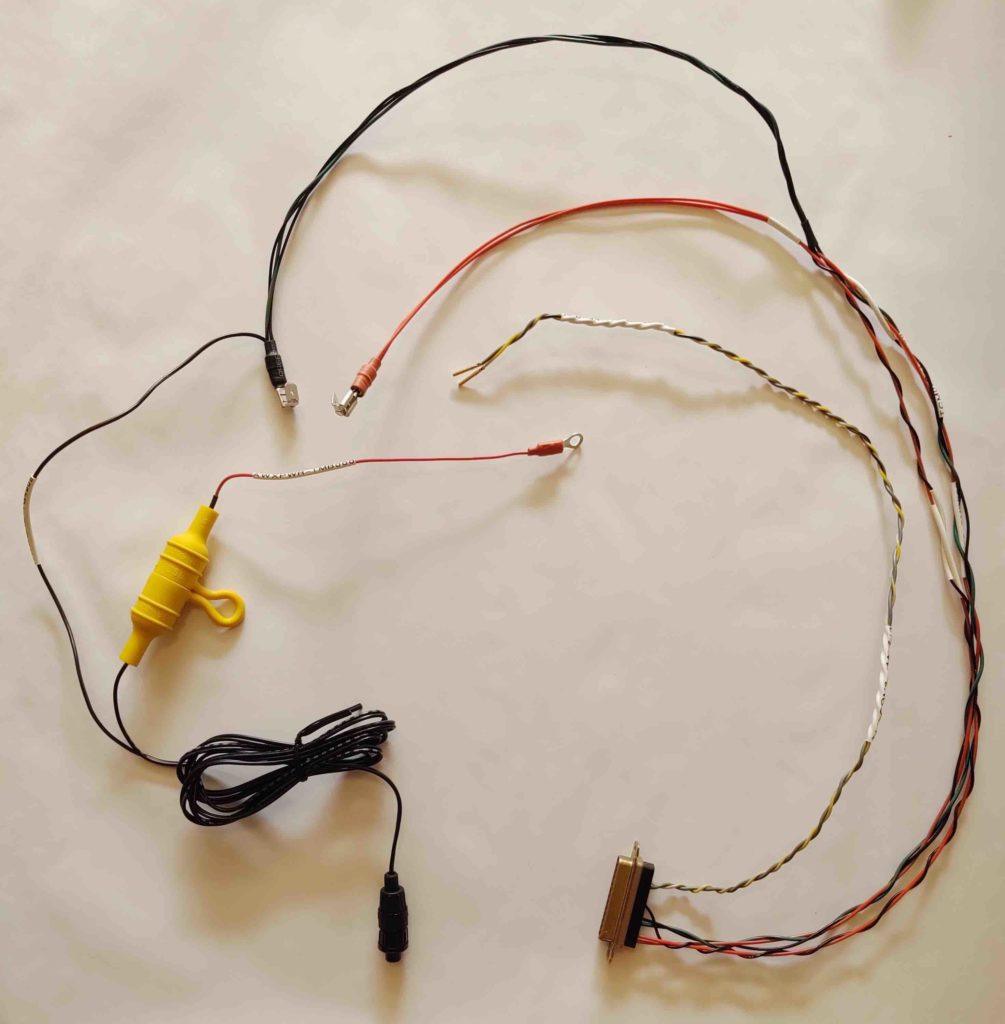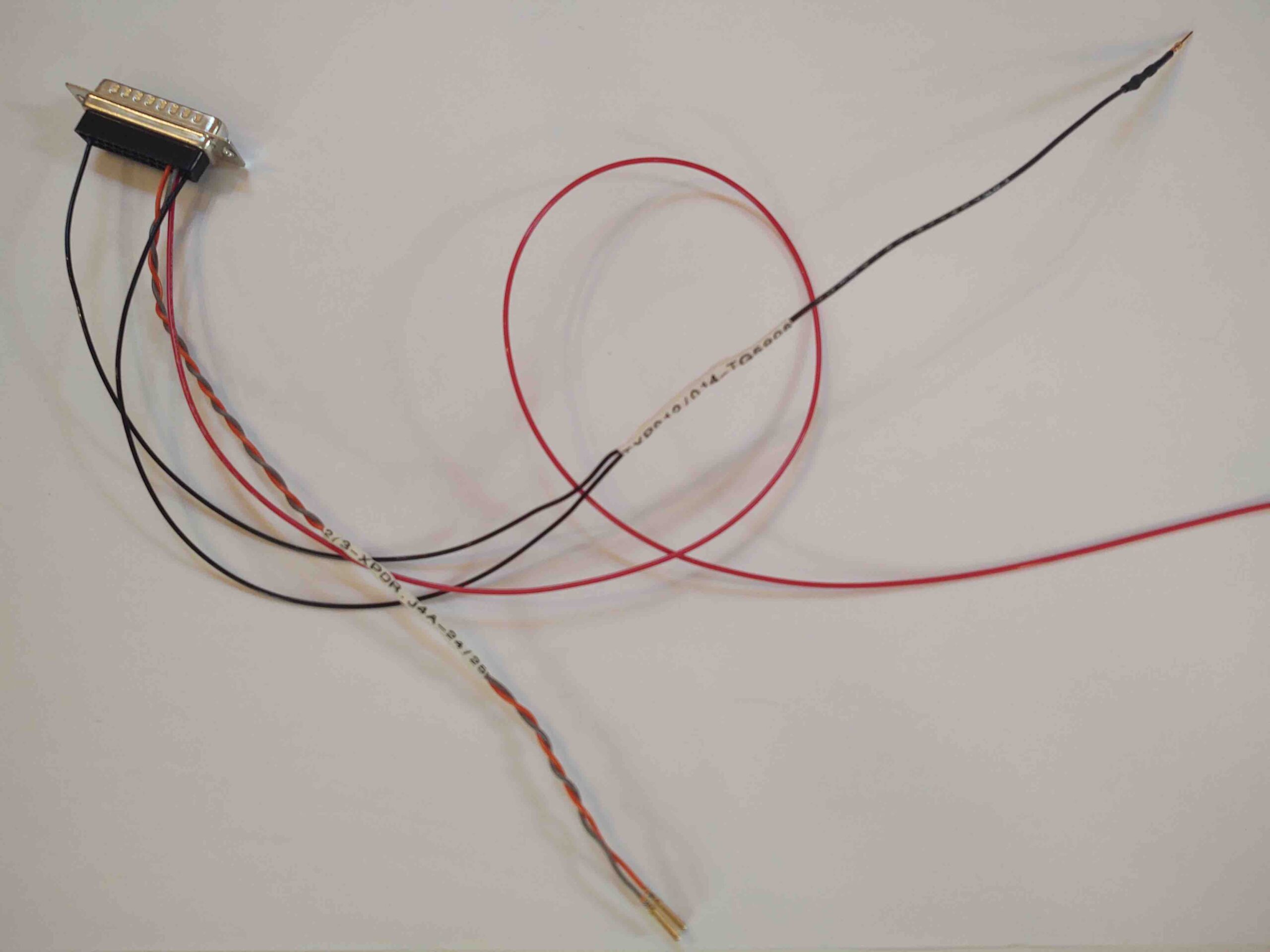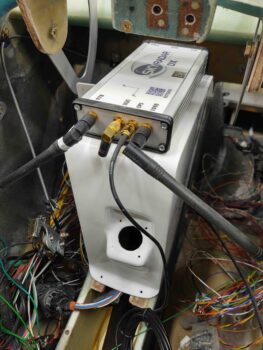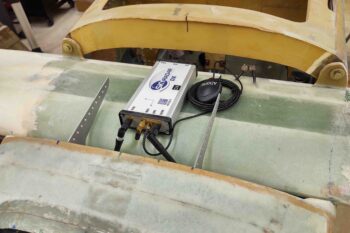Chapter 22 – Avionics, Instruments & Accessories
5 June 2013 — I grabbed the 2 RAM ball mounts that I had just received from Aircraft Spruce to mock them up. My initial plan is to have one RAM ball mounted to the Right-side fuselage wall in the hardpoint I embedded just aft of the instrument panel–as I have mocked up in the pic below (I posted this in Chapter 22 since it deals with the panel).
The other RAM ball mount will be mounted on the center instrument panel post. The bolts used to attach this RAM ball mount will also serve to attach the bracket on the pitch trim actuator for my Davenport pitch trim system (also shown in the picture below is my Andair fuel valve).
The screw used in the above picture is a AN3- (3/16″) vs an AN4- (1/4″) screw/bolt that will be used to attach the RAM mount & pitch trim actuator bracket.
[Operational Note: Since I have switched my pitch trim system to utilize the Atkinson pitch trim, which uses a different actuator, I am currently NOT planning on using the pitch trim actuator or bracket shown above. Although I do still plan on using the RAM mount on the panel.]
•••
11 June 2013 — Today was a light build day (no pics).
I also did some research on autopilots, specifically checking out the Trio autopilot models. I also built a couple of cardboard & duct tape mockups for the Garmin GNS430W GPS & Trio Gold Standard servo. I played around with the position of those components for a while in the avionics bay behind the instrument panel.
•••
13 November 2013 — Well, since I’ve been researching out my avionics & instruments alongside my engine components, I’ve started scheduling out some purchases for some of the panel avionics that I know I’ll for sure be installing. One such item I serendipitously stumbled across in my research is the Flight Data Systems AFP-30 Air-Data Fuel Computer. This guy was developed by a RV driver to add some more data points that he wanted to see in his cockpit. After researching this out and cross-referencing it in a matrix I have to compare all the functions of all possible avionics and instruments, I decided that this was definitely going on my instrument panel to provide me both unique & back-up instrument capabilities.

The AFP-30 performs functions in 3 main areas:
Air Data Computer
- Altitude
- Density Altitude
- Indicated Airspeed
- True Airspeed
- Mach Number
- Total Air Temperature
- Saturated Air Temperature
- Winds Aloft
- Crosswind Component
- Headwind Component
Fuel Flow Computer
- Fuel Flow (Gallons/hour or Liters/Hour)
- Fuel Used
- Fuel Remaining
- Fuel to GPS Waypoint
- Fuel At GPS Waypoint
- Range
- Endurance
- Fuel Efficiency (NMPG, MPG, MPL)
Performance Computer
- Manifold Pressure
- RPM
- Percent Horsepower
[Operational Note: Due to weight and moreover, panel space (or lack thereof) I am currently NOT planning on using the AFP-30 on my panel.]
•••
4 January 2014 — The plan right now is to definitely have full ADS-B by using the Trig S-mode Transponder and a capable ADS-B receiver to provide that capability. I have to say that one thing I really like from the GRT folks is they tend to play nice with others, this means options. On GRT’s page where they discuss the various ADS-B receivers that will integrate nicely with their EFIS systems, they provide some pretty good info. Of course, I original set my sights on the Navworx ADS-600B, but after looking at & assessing my actual bottom line requirements I decided that if I am going to have enough funds available to get this bird in the air within the next 10 years, I better forego the almost $2600 receiver and get a little more pragmatic (my primary goals were to have an ADS-B receiver that would integrate with my Trig S-mode transponder, display weather & traffic data on both my EFIS display and iPad, and meet the FAA’s 2020 ADS-B requirements).
Enter Radenna’s SkyRadar ADS-B Receiver. Although at first glance the SkyRadar seemed to be nothing more than a portable receiver, as I looked at it more and more it seemed to be a very capable receiver. And, as with the many components I’m looking at or have bought, a number of the RV drivers give the SkyRadar enthusiastic thumbs ups. So, the SkyRadar went on the list as the most likely candidate that I would purchase in the future for my ADS-B receiver.
You may be asking, “What happened?” Well, if the recent past tells you anything, then you’ll know that I’m cheap… and in being cheap I refer back to my oft cited mantra that sometimes you’ve got to spend money to save money! Ok, the bottom line is I went to Radenna’s website to confirm some info on the SkyRadar-D, when lo & behold they had just come out with the SkyRadar-DX . . . which includes a built-in AHRS! Moreover, they had a sale where the first 50 buyers get $200 off the price that the SkyRadar-D normally sells for. So, after a few hours of conformational research to ensure this was in fact the ADS-B receiver I wanted, I pulled the trigger.
So here’s the info on this device:
SkyRadar-DX Dual Band Receiver with Built-In AHRS
Key features:
- SkyRadar-DX’s operating frequencies are 978MHz and 1090MHz and the latter conforms to DO-260 standard.
- 5Hz GPS receiver
- Artificial Horizon Information
- Output data over Wi-Fi network (multiple displays can be connected)
- Operates as Wi-Fi Access Point
- USB high speed serial port output
- Input voltage 11-36 volts
- Power consumption less than 5 watts
The SkyRadar Receiver contains the following major components:
- UAT receiver tuned to receive and process ADS-B data
- High accuracy GPS module
- WiFi module transmitting data to iPad, iPhone or iPod Touch
•••
26 January 2014 — Just an update on the continuing project planning & component acquisition efforts. I have been spending a lot of time both on my electrical system & subsequently on my instrument panel. As I get more research under my belt, gain a bit more knowledge, and figure things out, I then of course ask my building buddies what their plans are for whatever I’m currently carrying on about.
In one of the latter iterations of my planned instrument panel, my buddy Marco noted the myriad of redundant capabilities I had for simply displaying airspeed and altitude. Of course I want SOME redundancy in my systems for backup purposes, but having 4-5 different ways to measure airspeed may be a bit overkill! I hadn’t intentionally planned on having this many, just so many of the newer avionics these days have built in extras that may add more than we need if we go back and assess our actual requirements.
One of my primary culprits in this area was the TruTrak Gemini PFD. It’s a great piece of technology and really has a lot packed into a nice, small package. But when I went back and re-assessed my requirements, I had included it on my panel for one primary reason: as a backup attitude indicator. I had accepted the fact that it provides airspeed and altitude information simply as a bonus. But at what cost? Cost here meaning actual money, since at 5.4 ounces it wasn’t necessarily breaking any feasible weight allowance thresholds.
So, in the vein of saving money and sticking to a prioritized plan to get this project in the air soonest, I decided to forgo the extra ASI & ALT features built into the Gemini PFD and focus on the primary capability I needed here, again, simply a solid backup attitude indicator. In my ensuing research I found a TruTrak ADI for sale on Ebay for way below half the cost of a new Germini PFD (and well below the new touchscreen 3-1/8″ TruTrak ADI as well). After a number of emails back and forth with the seller–who had just pulled it out of an RV-8 during a panel upgrade–I decided to pull the trigger.
Now, I will suffer about an 8 ounce weight penalty vs using the Gemini PFD/ADI, but for now I’ll simply put the Gemini PFD/ADI (or whatever future equivalent) in the “planned upgrades” category, to be purchased down the road after my bird is flying. Swapping TruTrak for TruTrak will be a fairly easy upgrade both physically & electrically, but will of course require a new weight and balance . . . but most likely I’ll have a few more upgrades & modifications in the mix around that same timeframe, so I’m sure a new W&B will be in order regardless.
Thus, introducing the latest addition to the instrument panel:
TruTrak ADI (3-1/8″) Features:
– Gyro / VS pitch display
– Bank Angle display
– Built-in Ground Track DG (via built-in GPS)
– High Bank Angle Warning
– Low Airspeed Warning
– Slip/Skid ball
•••
12 February 2014 — Instrument update. Oddly enough, I have had the Trio Autopilot on my list for quite some time now as a January 2014 purchase. Admittedly, I vacillated between buying the whole autopilot system or just buying the servos. Specifically, I was looking at the Trio Pro Pilot, and to be clear, I put it on the “to-buy” before I knew I was going to spend a year in the Middle East for Uncle Sam… thus planning to be much further along in the build.
Now, I’m going to digress just a bit to elaborate on how I came to the decision to go with the Trio Pro Pilot Autopilot. I had never heard of Trio before the Summer of 2012, when I was engaged in one of my many research sessions on Mike Beasley’s site. On his panel, he had a cutout of the Trio EZ Pilot. Being the curious type and intrigued as to Mike’s choice of autopilot, I did some research on a new found prospect. After watching a couple of YouTube videos on the Pro Pilot–that took something to me that was something shrouded in a cloud of mysticism and magic (i.e. autopilots) & making it all look simple–I was initially sold on the Pro Pilot.
That all being said however, I do TRY to approach my aircraft component selections somewhat clinically and empirically, so during my time in Tampa, Florida, I set out to confirm my initial feel-good thoughts on the Trio Pro Pilot by contrasting and comparing to other autopilots. The contest came down to the Trio Pro Pilot and the GRT “insta-” autopilot (just add servos!).
Now, there was no doubt in my mind that GRT’s autopilot was fantastic, as well as cheaper and lighter, but three things stood out in my mind for the Pro Pilot being just a cut above GRT’s autopilots. 1) Redundancy. GRT can easily run the Trio autopilots, but at the same time, if my GRT EFIS fails, I still have a separate autopilot system that is separate from my EFIS system. 2) Ease of use. Either the guys at Trio are true geniuses or just completely lucky, because IMO they absolutely nailed the interface and created an autopilot that is really darn easy to use (I think it’s both, but no doubt the Trio guys are geniuses… and great to work with!). 3) Integration. Lastly, since the Trio guys are EZ guys, there are clear-cut specific instructions on how to install these things into a Long-EZ, Cozy, etc. No guess work or interpolating!
Ok, so back to my component purchase plan. After pondering it a bit, I rearranged my purchasing plan and kicked the Trio Autopilot can down the road. I figured all major electrical & avionics purchases should wait until I’m farther along in the build. Besides, I still have one major purchase left for the engine: the cold air induction system from Sky Dynamics. Thus, I demoted the Trio and moved up the cold air induction system and felt pretty good about holding to a prioritized plan.
Ahhh, but fate & irony always play into the story, eh. In January, as I was spending some time perusing eBay for stuff, I ran across a guy who was selling his Trio Pro Pilot servos that he had picked up a few years ago for his Zodiac 601XL project. His price was not that far below what a new set of servos would cost, so out of curiosity I inquired Chuck at Trio about any possible upgrades or mods that might be needed on some servos that were a few years old. Chuck did confirm that there had indeed been some upgrades in the past few years, and that they would be happy to upgrade the servos to new specs if I purchased them. Well, after doing some cost analysis, it just wasn’t worth getting the older servos. So I let the servos go and moved on to other things.
Well, I noticed about a month later that, apparently, the gentleman selling the Trio servos wasn’t able to sell them and had them back on eBay for a much lower starting price. Thus, armed with the knowledge and known cost for upgrading the servos to new specs from Chuck at Trio, I had a cost window to operate within for possibly getting the servos and saving a fair amount in the process. Well, being a self-proclaimed eBay sniper I watched the auction for 6 days, and in the last 10 seconds there were 2 other guys that bid on it, but I was fortunate enough to win the bid.
Having pre-coordinated with Chuck on my intentions, I had the seller send the servos straight to Chuck at Trio, where they checked them out, made a couple of upgrades to bring them up to new specs, and then function tested them to ensure they were A-OK operationally. With the hundreds of dollars I saved on the servos, I had Chuck throw in a Trio Pro Pilot wiring harness and a few hardware pieces specifically for a Long-EZ install. Below are some pics of my new Trio Pro Pilot Servos.
I feel fortunate to have found these servos, and ironically stick to my original purchase plan, even though I had changed it. I feel compelled to quote an old boss here as he defined “luck” as “when preparation meets opportunity.”
•••
6 March 2014 — After reviewing my intended mission profile and realizing that using the Long-EZ’s range in traversing the US–meaning midwest thunderstorms–as well as flying up and down the mid-Atlantic region with its inherent summer thunderstorms, for safety and increased comfort factor I wanted some form of real-time lightning detection capability… above and beyond NEXRAD weather. I researched out the various lightning detection systems, and decided that I would like to install either a Stormscope or an Insight Strike Finder.
I found an older Strike Finder on eBay and decided it was worth purchasing. Although it was an older model, I had pre-coordinated with Insight Avionics to check out and upgrade the unit to an Ultra Bright LED display. This upgrade replaces the face of the instrument so that not only is the display much more readable and reliable, but the the entire instrument face is brand new.
I was able to buy both the control head and the sensor unit (antenna) as well. I shipped the control head and sensor off to Insight where they provided a sensor cable, and checked out the unit. After the control head & sensor units checked out fine, the Insight techs upgraded the display to the Ultra Bright LED.
Here’s the actual unit (before upgrade) shown below:
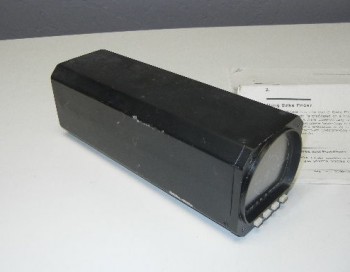
Here’s a description of Strike Finder’s capabilities from the Aircraft Spruce site:
The STRIKE FINDER® Digital Weather Avoidance System detects and analyzes the electrical activity emanating from thunderstorms within a 200 nautical mile (nm) radius of the aircraft. A unique graphic display plots an accurate, reliable and easily-interpreted picture of electrical activity that you can use to circumnavigate the hazards associated with thunderstorms.
The STRIKE FINDER® System analyzes the individual strike signal properties to determine the bearing, range and severity of the activity. Strike data is plotted on the display as single orange dots by range and azimuth, in relation to the aircraft symbol (“heads up”). As the number of lightning strikes increase, so does the number of plotted strike dots. Cells start to form indicating increased lightning activity.
[Operational Note: Due to weight and moreover, panel space (or lack thereof) and after a long discussion with Nick Ugolni on the difficulties of mounting the Strike Finder into a Long-EZ, I am currently NOT planning on using the Strike Finder in my Long-EZ.]
•••
21 March 2014 — I received the Strike Finder system back from Insight after they upgraded the display to a bright LED one. Quite a contrast (literally) from the old style plasma display. They also did a complete checkout of the system, including both the control head and the sensor. In addition, I had them throw in a new cable that links the control head to the sensor.
Note all the re-certification documents for the individual components in the right side picture below.
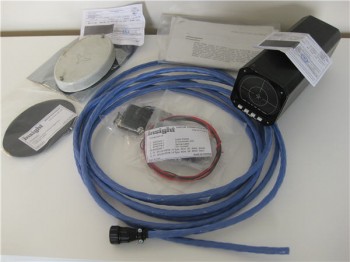
I have to say that the folks at Insight are a great group of people that are both extremely pleasant and very helpful to work with. They explained everything in depth, laying out all my options in a very clear and detailed manner. I am very impressed with this company.
[Operational Note: Due to weight and moreover, panel space (or lack thereof) and after a long discussion with Nick Ugolni on the difficulties of mounting the Strike Finder into a Long-EZ, I am currently NOT planning on using the Strike Finder in my Long-EZ.]
•••
24 March 2014 — I got the idea for installing a fuel fume detector from the RV guys over on the VAF forums. It makes sense to me especially in a plastic airplane like the Long-EZ where almost the entire fuel system resides in or around the cockpit. I definitely want to know if I have any hint of a fuel leak as soon as absolutely possible.
There doesn’t seem to be many fuel vapor sensors out there on the market, and a few of the RV flyers swore by the Xintex Fireboy Fuel Fume Detector. Now, these are actually sensors used in the boating community to sense any problems in their engine compartments. So I bought one off a guy who recently installed it in his boat, but then decided to swap his boat engine out with a diesel motor. Thus, I was able to get it much cheaper than what they sell for at the normal boat supply retailers.
The pics below show the control head face, the vapor sensor and the connecting cable between the two:
You’ve probably noticed this on my instrument panel pictures. I’m not sure if I’ll actually mount it on the actual panel or not, but I normally mock it up to see if I will have space for it if I do decide to panel mount it.
•••
28 March 2014 — I have to say that in addition to Insight, the company that makes the Strike Finder, I’m so far quite impressed with the folks at Radenna who offer a line of SkyRadar ADS-B Receivers. Back in early January when I purchased their latest ADS-B receiver, the SkyRadar-DX, they stated they would be shipping on March 20th, and they did exactly that!
The DX model is different from the previous SkyRadar ADS-B receiver models in that it offers WiFi (Apple, Windows & Android compatible) with attitude indicator (PFD) information displayed over the WiFi channel. Of course the standard ADS-B info, traffic and NEXRAD weather, is transmitted to wireless devices as well. Like the SkyRadar-D, one nice thing about this unit is that it receives both 978 and 1090 MHz signals.
The wireless is a bonus since the primary operation of this system will be via a USB connection between the ADS-B receiver and the GRT EFIS, so all ADS-B info will be available on the EFIS screen.
Also, remember that the ADS-B receiver is only one half of the ADS-B equation, in that to fully utilize all that ADS-B has to offer a Mode-S transponder must be used as well. I’ll be using Trig’s TT-22 mode-S transponder that will be remotely mounted behind the panel and controlled through either of my GRT displays.
So without further ado, here are some pics of my new ADS-B Receiver.
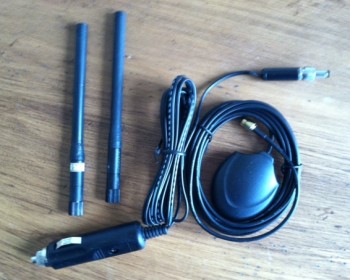
To watch a short YouTube video showing the setup of the SkyRadar-DX ADS-B Receiver click here.
For a longer 10 min video showing the moving map & traffic features click here.
To see the SkyRadar NEXRAD weather in action check out the short video below:
•••
2 April 2014 — Today I finally pulled the trigger on some behind the scenes–or rather, behind the panel–components. While some EFIS systems like Garmin make use of Micro-SD cards for updates, etc, GRT uses USB for software updates, system backups, and historical logging of flight and engine data. In addition, GRT’s remote BlueTooth capability and the Radenna SkyRadar-DX ADS-B both tie into the system via USB. To have enough capacity, including having a panel-mounted USB jack, I needed to acquire a USB hub and the remote panel jacks that allow me to simply plug my USB stick right into the panel.
There are a couple industrial strength USB hubs that GRT recommends on the advice of a number of builders that have trial tested these devices. I opted for the StarTech 4-Port USB Hub because it was significantly cheaper than the other recommended 4-port hub, it got great reviews on Amazon, and its configuration.
As for this hub’s configuration, you can see in the pics above that ALL of the inputs for both power and data reside on one side of the hub. The other recommended hub had inputs on both sides of the hub. In my opinion, having all the inputs on one side makes it easier in both mounting the hub and in managing the cabling & wiring.
As I mentioned above, in order to tie both the main GRT EFIS and Mini-X EFIS’s rear panel USB ports to the instrument panel in the way of panel-mounted USB jacks, I ordered one cable per EFIS that has a standard USB plug on one end and screw mounted female USB jack on the other. Obviously this will allow plugging the USB stick in at the panel and give me the same capability as if I was plugging it into the back of the EFIS box. Below is a pic of the panel side of this cable, and a diagram showing the technical specs of the cable:
•••
25 June 2016 — Today I finally received one of my instrument panel items that I’ve had on the list of things to buy for years now! About a week ago I pulled the trigger on the Trio Pro Pilot Autopilot control head. If you recall, I bought the servos from a guy off of eBay a couple of years ago and had them sent straight to Chuck at Trio who upgraded and ops checked them to ensure all was good.
This autopilot unit has the GPS Steering (GPSS) and GPS Vertical Steering (GPSV) options on it, with the GPSS allowing the Pro Pilot to receive GPSS commands from the GRT EFIS or Garmin via ARINC 429 data outputs. The GPSV allows the autopilot to receive pitch steering commands from a WAAS GPS receiver for precision approaches using GPS.
In addition, after a lot of discussion over the years, Chuck tweaked one of the pull up resistors in this Pro Pilot’s innards so that it can receive fuel data from the FT-60 Red Cube fuel flow meter along with the GRT EFIS. This gives me fuel management on both the EFIS and the Pro Pilot, which provides some pretty nifty fuel flow information.
•••
25 July 2016 — It’s funny to me how I can ponder on something for a fair amount of time and then as if by putting mental energy into a concept, it reveals itself in a some what short amount of time. As with many things lately, certain discussions have fostered various thoughts about various instruments, avionics and switches on my panel. Yet another discussion I had with Marco about his recently purchased Long-EZ –which incidentally has proven to be quite the test bed in that the handful of discussions that we’ve had concerning his new bird have spawned a number of viable system designs mods in mine– and the comment that he made on wanting to have a Garmin-free bird (due to their high prices on data updates), got me to thinking a bit . . . but admittedly, with everything that’s been going on lately, I really wasn’t thinking that much on it!
What I had been thinking about for some time was having a GPS with a decently larger screen size than the GTN650, but one that would still fit comfortably in my panel. In fact, I was thinking about this even more after I learned that GRT had debuted (FINALLY!) the 8.4-inch HXr at this year’s SNF.
Well, not sure if you got a chance to read Vic Syracuse’s article on the Avidyne IFD540 GPS Navigator in the August 2016 edition of Kitplanes Magazine. All I can say after doing a bit of research for the last 3 days on this puppy is WOW! This guy is packed with a ton of features, and in addition, its screen size falls right in between the GTN650 and the GTN750, so it looks like it will really work well for my panel size.
Moreover, the Avidyne IFD540 is a drop in replacement for the Garmin GNS430, so the pinouts are nearly the same as it is with all Garmin GPSs. I spent about a half hour confirming and updating all the component crosslink pins to ensure that this would work in my electrical system’s wiring schema, and it does! I had to change the actual pin ID numbers on about 70% of the pins (the D-Sub connectors identifying numbers are different as well), but did the swap in my wiring diagrams in short order.
[Operational Note: Currently I am NOT planning on using an Avidyne GPS navigator in my Long-EZ, but rather after much assessment and cost-benefit analysis I decided on and bought a Garmin GNS480]
•••
18 October 2016 — [Note: I’m placing this here since the Electrical System: Part 1 page is filled to capacity] Today was all about getting the Trio Pro Pilot Autopilot pitch servo mounting bracket glassed in place on the right fuselage side wall. Since I prepped everything last night, it allowed me to just jump into the fray this morning.
I started by cleaning off the Clickbonds with Acetone & then adding a dab of 5-min glue to the bottom of each one. I had them in place in the mounting bracket to allow me to align the Clickbonds to the actual pitch servo bottom mounting plate when I glue them to the sidewall.
I then lined up the whole assembly and pressed the Clickbonds into place onto the fuselage sidewall. I held it there by hand for about 3 minutes to ensure the 5-minute glue set up. I kept the bottom edge of the mounting bracket aligned with my angled alignment mark that I had made on the side wall, and my left-right alignment was my arrow on the lower left corner of the mounting bracket that aligns with the intersection of the slanted alignment mark and a point 7-3/4″ aft of F22.
After a few more minutes I pulled off the mounting bracket from the Clickbonds, and after a few double-checks on their alignment, let them cure. The middle dark area just to the right of the left row of Clickbonds is actually a 2-ply BID layup I threw on the side wall to help fill in the elevation gap between the uber 4-ply BID that secures F22, and the sidewall just aft of all that thick BID pad [not a big deal, but perhaps the install could have been better engineered by the Trio gang to avoid this 4-ply BID pad-to-sidewall transition area?….still, no big worries].
As the Clickbonds cured I whipped up some epoxy and wet out the prepregged 3 plies of BID. I then used the mounting bracket to mark the BID to allow me to cut small holes in it for the 6 Clickbond access holes.
I then whipped up some flox and applied it around each Clickbond base and in the transition area to provide a straight foundation for the mounting bracket.
I then laid up the prepregged 3 plies of BID. While the prepreg plastic was still on, I taped up the bottom of the pitch servo for anti-gunk protection and used the actual servo to press in on the flox to attain the exact amount of flox angle required for the servo to sit flat against the sidewall.
I then pulled the peel ply top plastic, applied a bunch more flox and then set the mounting bracket into place. I then laid up the 2-ply BID prepreg over the mounting bracket. Again, with the prepreg plastic still on, I once more set the actual servo on the Clickbonds and applied firm pressure to set the mounting bracket, flox and BID plies into place.
I then pulled the prepreg plastic and peel plied the entire layup.
•••
25 October 2016 — Last night Marco & I fired up the GRT Mini-X EFIS for the first time ever. Marco was curious to see how it looked and requested that we take a look, so we messed around with the screens, menus, features, etc. for a good while. We didn’t take any pics last night, but below is some of what we saw with just power and the GPS antenna hooked up to the Mini-X.
Primary Flight Display (PFD):
Navigation Maps (Track up & North up):
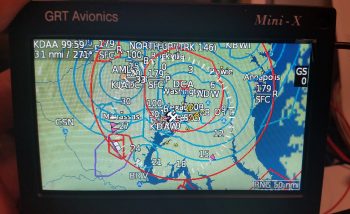
HSI:
•••
6 February 2017 — If you followed my blog you know that I was on a brief hiatus from building to finish up my Instrument rating.
One reality that I had to accept in preparing for an upcoming Instrument flying stage check was my lack of understanding of the Garmin GNS430 GPS navigator, which happened to be installed in all the Cessna 172s that I was flying for training. I had resisted in really getting deep in learning the GNS430 since for my Long-EZ, my plan was to install an Avidyne IFD 440/5×0 GPS. But alas, with a couple of stage checks and my FAA check ride looming on the near horizon, I realized that I really needed to nug out some training on the GNS430. This decision was made easier in part when I received an email from the ubiquitous King’s offering a 20% discount on any of their training courses. So I pulled the trigger and bought the King GNS430/530 training course (which is pretty good by the way).
As I was just getting into the 430 training, I was thinking I would buy a 430W to install in the Long-EZ since I use it so much in my training airplanes. With the completion of my Commercial rating still looming on the horizon, I would still require a lot of time behind the 430. Since the Avidyne IFD440 is a slide-in replacement for the Garmin GNS430W, why not use the 430 now and simply replace it with the IFD440 later? Sounded like a good plan. For clarity, I discussed this at length with Marco who agreed with the merits of my logic (although being a big Iron driver, he’s not a big fan of the 430).
Although it wasn’t my intention initially, as I dug deeper and deeper into learning the GNS430, curiosity of how its features compared to other units got the best of me. So during breaks in training I would sneak in quick peeks at the Avidyne and GNS480 features. As I would Google certain features that I wanted more info on regarding the 430 (holds, OBS, airways, etc.) I kept coming across overwhelmingly positive reviews on those features for the GNS480 [Admittedly from those bubbas flying behind them… to the guys that hadn’t flown the 480s, the report was that the learning curve was ‘too steep,’ the interface ‘too FMS-like,’ and a constant projected fear of no further Garmin support on these units].
As my curiosity deepened, before bed one night I spent a good 45 minutes watching a video specifically on the GNS480 operations. I was deeply impressed with the power & capability of the GNS480, and every chance I got I would spend a few minutes here and there researching it more. After a day or so of this, I sent the 480 video to Marco with a good hunch that he’d really like this unit as well (he did!).
If you’ve ever gotten a feel for my modus operandi, it will probably not surprise you that I was already communicating with a number GNS430W sellers in line with my latest 430W plan. However, there was an oddity playing out during my short-lived quest to acquire a 430W. First, nearly every seller of every 430W unit that I engaged with turned out to be a scammer. Moreover, I spent a good week working a promising deal that in the end turned out to be yet another scam.
However, I guess all things work out for a reason, because during the week I was working the potential 430W purchase with what turned out to be yet another scammer (NOTE: nearly every 430W listed on Barnstormers and other sites turned out to be a scam), I was concurrently learning more and more of the GNS480’s capabilities. Remember, during the majority of this time I was practicing instrument approaches and studying IFR flying. Truth be told, this training was probably the tipping point in my choosing the GNS480 over the GNS430W. Why? Well, as I re-flew my recent actual IFR flights and approaches on the respective 480 and 430 simulators side-by-side, the GNS480 clearly had superior capabilities when it came to flying IFR flights and approaches (in my opinion). [I’ll expound on the specific comparisons in a later post].
To be clear, with the great price (but not unrealistically low) that I would have paid for the GNS430W that I was dealing on, I would still have gladly bought it and installed it. My requirements goal here was to install a lower cost WAAS GPS unit that allowed me to fly my Long-EZ IFR. Nonetheless, by the time I determined that the 430W seller that I was dealing with was a scammer, I reset my search primarily on finding a quality, well-priced GNS480 unit. Well, in short order I was able to serendipitously do just that, finding a local GNS480 seller (and experienced pilot) that had a unit for sale.
I met with the seller, Phil, at a local airport where I was able to play around with the unit in its Commander docking station. The fact that Phil was selling an entire Plug-n-play package was the deciding factor in why I pulled the trigger on this unit. Here are all the components that were included:
- Garmin checked & software updated to Vers. 2.4 and 5.1 (allows ADS-B+ out)
- Mounting tray (“tube”), backplate and electrical & coax connectors
- GA 35 WAAS GPS antenna
- Data card reader + 2 data cards
- Lone Star Commander docking station
A result of my evaluation, and subsequent purchase, of the GNS480 has brought me to the conclusion that this will be the final and only GPS unit that I plan on installing in my Long-EZ. Clearly this means that my proposed Avidyne upgrade is simply off the table now. With the GNS480’s handling of voice and nav comms, its inherent WAAS GPS/VOR/LOC/ILS capabilities, and its fantastic handling of airways, I am more than thrilled to have made my decision final in identifying this GNS480 as Long-EZ N916WP’s long term GPS navigator unit.
•••
6 August 2017 — I spent this past week in North Carolina coast and Virginia Beach. This is significant for my build in 2 regards:
First, motivation. Coming back from NC via Virginia to visit Marco & Gina, Marco flew down to New Bern, NC and picked me up and flew me back to his EZ’s home base at Chesapeake. At 45 minutes airport to airport and averaging just over 6 gallons of fuel an hour, you can bet I’m motivated more than ever to finish my Long-EZ!
Second, Spending a few days with Marco and Gina was great of course. Since Marco is actually interconnecting all his panel upgrade components (GRT EFISs, Garmin GNS480 GPS, etc), it gave me a lot more insight on the configuration settings required to get all these panel components to talk to each other.
With all this configuration settings stuff fresh in my mind, when I returned home on Saturday I spent about 3 hours digging into the manuals to facilitate adding port speeds, port labels and IDs to my wiring diagram interconnect wires for my PFD, MFD, GNS480, Trio AP, transponder, etc. With a deeper understanding of the ARINC connections, this process also allowed me to further find a couple of design configuration questions that I need to get some answers to. So I fired off an email to Chuck at Trio to get some of those answers.
I continued my digression (or distraction!?) yesterday as I got close to wrapping up my panel wiring diagram by ID’ing specific wiring types (twisted pair, shielded, standard) for each cross connect. I also created a spreadsheet that IDs all the major programming configs for my separate panel avionics/instruments. I’ve already configured the majority of settings –as far as I can currently– on both my Garmin GNS480 GPS receiver and my GRT Mini-X EFIS.
•••
7 August 2017 — Well, as not that uncommon in this build, what was supposed to take a few hours ended up taking up every minute of my day today and propelled itself into the wee hours of the morning.
But my immediate task is done . . . for now of course! I tried a few different ways to get this on the screen, but alas my JPG captures on my CAD program suck. So I just took a screen shot (pic below). It gives you a general idea of what I was up to all day yesterday sorting through essentially a massive pile of spilled spaghetti.
I pretty much assessed every wire and every connection coming out of the GRT HXr EFIS (PFD), GRT Mini-X EFIS (MFD), Garmin GNS480 GPS receiver, and Trio Pro Pilot Autopilot. I identified if the wires would simply be run from point A to point B, or in a twisted pair or shielded conduit, all based on the requirements coming out of the installation manuals or the manufacturer’s guidance. Where there was no specific guidance I turned to words of wisdom from the grand pupa of aircraft electrons, Bob Nuckolls, by referencing his masterpiece, The AeroElectric Connection.
In addition I clarified some info via phone calls and emails as I did with Chuck from Trio Avionics. And will do the same with GRT tomorrow.
As I mentioned yesterday, I also labeled every RS232 serial pair and ARINC 429 pair for the data signal wires with their respective configuration labels and correlating baud rates that will be used when setting up the individual components to talk nicely amongst themselves. I was also able to reallocate and free up some serial ports based on my newfound knowledge and tweaking of my system (also facilitated by some updated manuals such as a new 2017 install manual for the Mini-X). This, in turn, both reduced the physical number of wires and allowed me to clear off unneeded ports that I was tracking on the diagram above.
With the wire types identified for each port, I was then able to massively rework my Panel Quick Disconnect (PQD) connectors and consolidate all the HXr EFIS harness wires on the J4 PQD 37-pin D-Sub connector. I was just short a couple of positions, so I moved the power off the J4 connector and repurposed the J10 connector label for a new 4-pin mini-Molex power connector (HXr primary, secondary and tertiary power plus ground). The old J10 connector got bumped down the line and is now J12.
Below is a page out of my connector pinout tracking sheets packet. I track literally every wire, pin & socket in every connector on this aircraft. As you can imagine, I’m waiting for the day when I can stop updating these sheets!
In addition, I did exactly the same thing in consolidating every wire for the Mini-X through the J3 PQD 15-pin D-Sub connector. This is very significant in that it allows me to simply unplug & remove my HXr EFIS by disconnecting only 2 connectors: a D-Sub & mini-Molex (ok, and a USB cable . . . you got me!). Moreover, If I choose to, I’ll be able to disconnect & remove my Mini-X EFIS by disconnecting 5 things: a D-Sub, a USB cable, the GPS antenna cable, and of course the Pitot & Static connections.
After I finished reworking my panel component wiring diagram and the pinouts for the 3 PQD connectors, I then did a scrub of every wiring diagram I have on hand, which is nearly 30 diagrams. In addition to the panel component wiring diagram, I had to do significant updates to 8 other diagrams.
To help bring all this massive paperwork drill to life so you can see it in the physical world, I went back and snagged a couple shots of the Panel Quick Disconnect (PQD) connectors in the PQD bracket (still in its rough state before cleanup) so you can see what I’m talking about. The 37-pin D-Sub J4 HXr connector runs across the top, while the 15-pin D-Sub J3 Mini-X connector runs down the right side. The big round 24-pin connector, which admittedly is sparsely populated now (read: scalability) is the P6 AMP CPC connector.
Here’s a shot of the PQD connector bracket at the aft right corner of the Triparagon’s top cross shelf. The PQD bracket is situated right below the aft face of the Trig 22 Transponder. In addition, the PQD connectors are only a scant 4.5″ (IRRC) from the aft side of the HXr and Mini-X . . . so close in fact that I could not physically install the cable clamp on the aft panel-side P6 AMP CPC connector and still have clearance to run all the wires!
•••
10 August 2017 — Today I called Mike at ACK to go over my ELT install configuration. He gave me some very key information that will be very pertinent to my ELT installation that in most regards will make the install much easier.
•••
27 August 2017 — Today I started out by spending a couple of hours updating wiring system grounds and my comm component interconnections in some of my wiring diagrams. I also figured out my Audio Mixer requirement and updated that accordingly.
•••
11 September 2017 — I didn’t get ANY actual building done on the plane today! Why? Well today I got a nice delivery from the UPS bubbas . . . you gotta love people who bring you airplane parts!
Hmmm? . . . a big box from GRT Avionics. This can’t be anything but good!
And what do we have here, 3 smaller boxes inside the big box.
Small box #1 revealed HXr EFIS accessories: GADAHRS, magnetometer, GPS antenna puck, OAT probe, and wiring harnesses.
I had already located my preprinted label stash and as each item came out of the box it got labeled with it’s 2-digit component ID. I also wanted to check the fit of the GADAHRS on the top cross mounting shelf of the Triparagon: perfect fit!
The bigger of the 3 boxes was the GRT HXr EFIS itself. I bought the smallest HXr EFIS GRT sells –the 8.4″ model– since I wanted to conserve as much panel space as I could. I figured it would fit well and still have exactly the same features as the large 10.4″ and 12.1″ models . . . actually more, since those models don’t have the optional touchscreen feature that I ordered on this unit!
You can see the top layer of the box contained more wiring harnesses, a thumb drive, and a display unit cross connect ethernet cable (that I won’t use since the Mini-X does not have an ethernet port… the displays will talk to each other via an RS232 serial pair).
And then I pulled out the centerpiece of my instrument panel: the GRT Avionics 8.4″ Touchscreen EFIS. When I started this EFIS journey years ago, I’d never imagine that the unit I’d get was even more capable than what I was asking for. I have to say that I’m extremely happy with the configuration, outlay and capability of my panel and avionics!
Here’s a shot showing the depth of the HXr EFIS.
And the back panel.
This shot gives you an idea of the actual size of the unit. It’s not like I have gorilla paws, so this EFIS is a perfect size for a Long-EZ panel (in my opinion).
I’ll reflect back on how it is to plan something for literally years and then finally have it come to fruition. This is my personal money shot right here. Finally… my HXr PFD & the Mini-X MFD, together . . . where they belong!
I then opened up box #3, which contained all the wiring harnesses and engine sensors for the GRT EIS4000 Engine Information (management) System. Since I needed a different MAP sensor that doesn’t come in any of the EIS4000 packages, I ended up getting the basic package and then just adding a couple higher quality sensors to the lineup.
And here’s the very capable EIS4000 control unit. A lot of builders simply place this in their panel and call it a day, and it will work well that way. But to spice things up a bit all you need is one little 22 AWG wire to port all that info via serial data into the HXr & Mini-X and you can see all the engine data in beautiful, colorful graphical representation.
I can’t even begin to relay how many phone calls that I fielded today. So besides inventorying the new orders and crosschecking interfaces with components I already have on hand, I finished out the evening by “simply” figuring out the configuration of my GIB headrest (aka “component storage facility”) which will house the following (top down, CW):
- Hobbs Meter
- EIS4000 Control Unit
- B&C SD-8 Backup Alternator Capacitor
- B&C SD-8 Backup Alternator Voltage Regulator
- B&C SD-8 Backup Alternator Self-Excitation Bridge Rectifier
- Princeton fuel level control unit – Left Tank
- ElectroAir EIS (Electronic Ignition System) Controller
- Princeton fuel level control unit – Right Tank
(That’s all . . . at least for NOW!)
Oh, and let’s not forget the other item I also received in the mail today: my diminutive (cool in itself) MakerPlane AMX-2A Audio Mixer that allows me to take all my GNS480 system and NAV reporting messages, combine those with Trio AP audio reporting and CO sensor audio alarm, etc. and run it all seamlessly into my Dynon Intercom. It has 10 channels so it can handle more than enough devices that I think I’ll ever throw at it. And, as you can see, it’s literally the size of a 25-pin D-Sub connector backshell [because it is one!].
•••
30 November 2017 — As many of you probably know, every year Seattle Avionics has an outstanding Black Friday sale where they provide lifetime subscriptions on their data at nearly half price for all the major EFISs, including Garmin, Aspen, Dynon, AFS, and yes, GRT. The map data they provide is geo-referenced sectionals, hi/low IFR charts, approach plates, and airport diagrams.
As to how good all this is, I’ll sum it up as someone said on the GRT forum: The charts are ok, but zoom out to past a 100 nm view and they’re virtually useless. I suspect that having the ability to zip around the map with a touchscreen EFIS (ahem!) makes them a bit more useful… somewhat analogous to using an iPad. The forum poster went on to say that the geo-referenced approach plates and airport diagrams more than made up for what the charts were lacking.
I still wasn’t going to pull the trigger until next year since, honestly, I still have quite a trek left to finish this airplane. However, when I got the email (and I’m glad they sent it) that said this was the last year of their deep-discounted Black Friday sale, I decided it was time to reluctantly break out the wallet. Moreover, having seen Black Friday sales in the past from other airplane related suppliers (ACS, Wicks) that are no more, I figured they weren’t kidding and for nearly half the price, I wasn’t going to take the chance that they were.
I started out by downloading Seattle Avionics DataManager Program that allowed me to pick what charts I wanted, including charts they offer for all of southern Canada, a bunch of Mexico, the Caribbean and the Gulf of Mexico… pretty nifty.
After downloading the data from the Seattle Avionics server, and then uploading it to a 32GB SanDisk thumb drive [which was a multi-hour endeavor to find and purchase] that needed to be pressed into service vs. the originally GRT supplied 8GB USB stick, I was quickly able to bring up the IFR low chart on my EFIS. Again, pretty nifty!
I then played around with the sectional chart for a bit. BTW, the guy on the GRT forum was correct: anything out past a 100 nm resolution and these charts are really not very useful.
I then had an issue where I couldn’t load up the approach plates, so while I messed about with trying to figure that out I decided to build my aircraft checklists and load them up into my HXr.
When Marco bought the superb Long-EZ that Terry Lamp built last year, he tweaked the checklist for a much more logically flow. He provided me with a copy and that’s what I used for the boiler plate to create these checklists. I then spent quite a few hours (as I was slowly uploading all the chart data for the surrounding states in my area) tweaking and updating the checklists with items relevant to my specific configuration.
On the left is a list of all the checklists I’ve created so far, and on the right is an example in the Preflight Checklist of each item getting checked off as it is completed. At first I wasn’t sure if I would like these on-screen checklists, and to be certain I will have a hard-copy version [that’s all I’ll have for the external walk-around part of the preflight], but I can see myself adapting to using these and not messing about with any physical checklist in the cockpit . . . especially when it ends up somewhere where it’s not supposed to be!
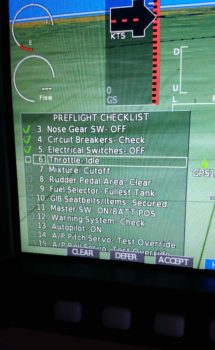
I wanted to show this shot of the right map inset (it can be located on either side, I just happen to keep it in its “default” location) with all the ADS-B traffic buzzing around. I live a few miles south of DC’s Reagan National Airport, so not surprisingly it shows a lot of traffic.
Moreover, my being in the traffic pattern affords the HXr to showcase one of its really cool features that I’m sure I’ve discussed previously: when traffic enters into an area that I’ve defined in the settings, it lights up the left inset with a Traffic Alert, as shown below. It will stay active as the left inset until the traffic has traveled outside those predefined distance parameters, at which point the inset will revert to what I had there before: typically an engine info screen detailing EGT and CHT data.
With the sectional chart up, I meandered my way down to the North Carolina coast where I plan to be living next year. While “visiting” down there I got a visitor in the way of another traffic alert. I love this feature so I grabbed another shot of it… no more pics of these, I promise (in THIS post!).
As I was finishing up this post, Jeff from GRT called to help me out with the case of the missing approach plates (key dramatic music!). Well, apparently I didn’t quite understand the process, and mind you it’s not specifically written down anywhere. Thus is the plight of us GRT users… yes, the learning curve may take a bit, and what it can do is not always straightforward, but I am constantly amazed at how versatile these EFISs are… but I digress.
I was trying to LOAD the approach plates into the EFIS by copying them over from the USB stick, which I didn’t realized simply can’t be done. Although I knew there was a lot of data, there is so much data that the EFIS merely reads it all off the thumb drive… much in the same manner, but way faster, as our Commodore 64 computers read the data off cassette tapes…ha!
Before Seattle Avionics came up with these nifty Geo-referenced plates, the only original method in play to get approach plates displayed on the EFIS (when GRT enabled the capability to do so) were PDF plates. These PDF plates are still a viable option and they’re free, but not geo-referenced. So the menu item still shows “copy” as a means to bring approach plates (ahh, but only PDF plates) onboard. For “chartdata” plates, in reality one simply just needs to go select an approach at an airport and load ‘er up (I had tried this early on but it didn’t work… it of course worked fabulously while I was on the phone with Jeff from GRT, so he called to confirm that there was actually no problem… haha!) Oh well, at least its working . . .
Below is a shot of a quick Direct-To flight plan I ginned up down to Chesapeake (I hope Marco reads this to know I’m coming to visit!) and the approach plate that I just learned how to effortlessly pull up.
Here’s a shot of a STAR (Standard Arrival Route) plate that I pulled up for BWI. The EFIS provides a way to turn, pan, zoom, etc. the plates to ensure you can see what you want. There are also other EFIS views with the approach plates (e.g. just the plate) if I wanted to set it that way, here I was just confirming that they worked.
•••
1 December 2017 — Today I spent a couple more hours tweaking the HXr-based checklists. Working on the HXr these few hours over the last couple of days has also given me a much better feel for the switchology and flow of this EFIS. In fact, so much so that it drove me to make some decisions to remove a remote switch control that I originally put in place when I was considering the older HX EFIS, and/or also an HXr that was non-touchscreen. The switch function I removed was the HXr Page Flip function. In addition, I have some ideas on what to backfill the open positions on my throttle handle 5-position castle switch, but will need some time to research those out as well.
These mini-mods on my system is exactly why I wanted to get the panel mocked up outside the airplane. which then allows me to work it through a shakedown cruise of sorts to better refine component/switch placement and cockpit management long before the panel is ever mounted into the actual cockpit. With each new install of a planned component, switch or software feature, it really does flush out these integration issues and often drives some minor changes for a much better operational flow.
I’m very much a believer in task efficiency in the cockpit to minimize what could really be classified as burdensome or unnecessary processes if we take a hard honest look at them. To be really honest, when I see a question asked on how make a cockpit task much simpler, with an old skool response of just mask the deficiency by adding it the checklist (because ALL pilots follow the checklist!… it would be sacrilegious not to!), I find it a lazy response and it personally disgusts me. Cobble a number of these laissez faire implemented processes together, and I’ll give you a needlessly task-saturated pilot who is spending more time reading a uselessly bloated checklist and not doing what he should be: flying his plane. Am I wrong? Sadly, I would say that many NTSB reports will show that I’m not. So… I’ve had a lot of very in-depth discussions on this topic with a lot of builders & pilots, specifically Marco and Dave B. I consider myself fortunate in that these discussions and collaborations often highlight areas that I have been able to optimize even further.
As for my task planning, honestly I’m a bit further behind then I wanted to be on that. I was planning to have it knocked out during my time away, and did scrub a couple old task/goal lists that I have, but the new one is still in its nascent stage.
•••
5 December 2017 — Yes, over the past few days it seems as if I’ve been fighting the un-overcomeable gravitational pull of finalizing my EFIS-loaded checklists. I’ve been wimping out a bit on getting into the cold shop, easily pulled away by the lure of cross-checking each respective piece of avionics, instruments, electronic ignitions, and components that are covered by the checklists.
A big focus of mine on the checklists was finally integrating & deconflicting the engine starting & run-up sequence between the SilverHawk fuel injection, P-MAG EI, and Electroair EI requirements as detailed in their respective manuals. I think my “shakedown cruise” analogy regarding the checklists was correct in that it actually brought a number of issues to light that need(ed) to be worked through.
In focusing on the GNS480 GPS and Trio autopilot part of the checklists, I realized I really needed to get it straight in my head how these two components work together with the GRT EFIS. Besides a number of sideline conversations with Marco on both checklists and GRT EFIS functions, including instrument approaches, I took a few hours to go offline and submersed myself into learning a lot more of how my GRT EFISs really work. This was also part of a specific effort to learn how the EFIS functions integrate with the GNS480 GPS and Trio autopilot.
And boy, did I ever learn a lot…. including that a number of my initial operational assumptions were off. I was pleasantly surprised that these components integrate much better than I had imagined, decreasing a lot of the workload I assumed I would have with three separate systems. Let’s just say that the ARINC 429 protocol is an amazing thing! Moreover, probably the biggest lesson this “young” (ha!) Jedi learned was that the Trio autopilot source selection [GPS or EFIS] default needs to be on “EFIS” so the autopilot is controlled by the EFIS, not the GNS480 GPS that I had mistakenly implemented. This allows all ARINC 429 data to pass through the EFIS to the autopilot, but still allows on-screen control of the autopilot via the EFIS (not quite a Doh! moment, but close….).
Below is a shot of the GRT HXr EFIS with the “Before Taxi” checklist pulled up with checklist items checked off as complete. The pic itself, as the one above and below, are screen snapshots, or “SNAP”s, that I took via the EFIS system with just one press of a button. Pretty cool, eh?
Getting into these separate manuals also highlighted some not so great aspects of my current system as well . . . ahem, but let’s call these either areas of opportunity or areas for improvement, shall we? One such area was the initial placement of the GNS480 GPS and Trio autopilot startup on the checklists. Since I “wanted” them on the “Before Start” checklist then that’s where I put them. But, after tweaking the lists and getting into the manuals, I was faced with “Doh!” moment 3,461 of this build…. um, can’t fire them up before engine start-up without a brown-out circuit! Hmmm?
I’m not quite so concerned about the Trio autopilot since it has a fairly fast boot-up time, and my input to the unit is minimal. However, loading a flight plan into the GNS480 while the engine is off is a big requirement of mine. Burning up gas (and money) needlessly and getting the engine all hot & bothered while not moving, is not cool in my book. So this led to a discussion with Bob Newman from TCW Technologies regarding his Intelligent Power Stabilizer and also some bubbas on Bob Nuckoll’s Aeroelectric Connection forum. Love Bob Newman and his products, but aiming for cheap as possible here, and I think once again Eric on the AEC forum is going to bail me out of a sticky wicket with his brilliance… for way less cost!
Here’s another SNAP, this time off the Mini-X. Yes, some blatant eye candy that I added just to spice this blog post up!
•••
7 December 2017 — I continued down the path of finalizing the EFIS checklists, to include my education on how the GRT HXr, Mini-X, Trio autopilot and GNS480 GPS all play together during normal sorties, and specifically during instrument approaches.
Since the “online” checklists on the GRT HXr are simple small-sized text files, it means that A) they take up very little thumb drive space, and B) I can add virtually as many as I want. Since the integration of my glass cockpit comes with a decently high learning curve, this led me to make crib notes for the pertinent functions, especially the ones that had either befuddled or eluded me for various reasons (typically ignorance, ha). I’m seriously under no illusions, knowing that after another 6 months of in-depth building I’ll have forgotten the majority of what I just learned… thus, hopefully my crib notes will facilitate glass cockpit mental reintegration much more quickly!
Besides continuing to add to my checklist library, it also got me back into the manuals and other various reference material specifically focusing on GRT EFIS-based instrument approaches. Case in point, a gold mine I found on the GRT forum from a response that Bob Turner (resident forum non-GRT-employee EFIS guru) provided a GRT newbie was a 3-page how-to for setting up the autopilot, managing climbs & descents, shooting precision & non-precision instrument approaches, and missed approaches. The only catch was that Bob’s notes were specifically geared towards an HX EFIS, which is close to the HXr, but requires a bit more button pushing.
In addition, my first real scheduled 28-day cycle navigation data update from Seattle Avionics was due, so while I fiddled about with figuring out the idiosyncrasies –and there’s a distinct few– of that process [I tried to do it overnight as Seattle Avionics recommended, but that didn’t work…. but I think I can get it to next time] I went to work concurrently testing out Bob’s 3-page knob-twisting and button-punching EFIS how-to on instrument approaches. I finally got the multi-hour Seattle Avionics nav data download completed [this data covers approach plates, airport diagrams, sectionals and IFR low charts] and was still into documenting pertinent information nuggets into my “online” (EFIS) crib notes, and morphing Bob’s instrument approach how-to’s into a GRT HXr and Mini-X based document that I could use.
It felt good dialing in the process for getting the first set of nav data downloaded from Seattle avionics and then uploaded onto the HXr’s thumb drive. Moreover, through the process of verifying and/or modifying Bob’s procedures, I learned a ton more about the EFIS/GPS/Autopilot functions and interfaces, nav modes, approach sequencing and just general familiarity with my panel systems. Also big was my more in-depth understanding of the capabilities of my Mini-X backup EFIS. All good stuff, which of course was fed into the checklists for yet another round of updating.
To perhaps express a bit clearer on these checklists, the minor issue in updating them is one of format. I prefer, if possible, for a checklist item to only be on one line of the checklist … I guess harking back to my military days of focusing on ABC for any communication: Accuracy, Brevity, Conciseness. So, when I say format, besides optimized verbiage, I often mean the difference between a physical one or two line checklist entry can be had by denoting “on” as “ON”, “On” or “on”. Or GPH vs gph, etc. Minor issue yes, but it’s one that I simply clean up on the fly as I add more info into my online checklist/crib note library.
I also engaged in some direct collaboration with Eric Page, ala Aeroelectric Connection forum, on maximizing the output of a Voltage “Deslumpifier” (brown-out circuit module) based on Eric Jones’ (perhiheliondesigns.com … and one of my electrical system mentors) original design. Initially Eric came back and stated that the specs for his new & improved Deslumpifier design just wouldn’t work for the GNS480. Then Joe Gore jumped into the forum conversation and sparked an offline discussion between me and Eric on building a supercharged version of his new & improved Deslumpifier, specifically for my GNS480 configuration. Over the last two days, Eric was able to spec out some higher powered capacitors (5-Farad per) that would both fit his board and give us nearly double the output for my supercharged (in comparison) Deslumpifier. Of course the proof will be in the pudding if it actually works or not, but based on Joe Gore’s provided numbers, it looks very, very promising… and again, all for much less than TCW’s Intelligent Power Stabilizer (again, not bashing TCW– great products).
So yes, alas, I got very little done in the shop. But to be honest, I didn’t mind straying from the playbook a bit during the cold winter months because it saved a ton of money from having to heat up a cold shop (or try to work layups all under heat lamps). And I have to admit it was really gratifying digging deep into these systems and learning their true, no-kidding operational capabilities.
•••
9 December 2017 — I started out today with another round of in-depth studying on the GNS480 GPS unit. I also tweaked some of the user’s manual as I did yesterday. I also made up a decently long list of configuration changes that I needed to make to the GNS480 box.
Once my “chores” were out of the way, I fired up the instrument panel to check out all my updates and see how well they worked. Plus –again– I had a number of configuration updates to input into the GNS480.
After I was done with all my checks and updates, I was going to take a few pics when I got a wild hair and decided to just film a video… so here it is:
Yes, it’s a bit lengthy (and bouncy) but hopefully it shows a glimpse of what I’ve been up to over the past week.
I also updated a number of electrical diagrams as I was waiting for the video above to render.
•••
26 January 2018 — Today I got some rubber “T” molding that is used at the edge of auto windshields and the window frame for sealing a windshield edge. I bought it off of Ebay because it was the only source of supply I cold find (I looked a while!) and had it shipped in from China. I checked it out a bit, then I trimmed it and mocked it up atop my pilot seat headrest (which will get repainted with my now standard interior scheme color later). The molding looks like it will do a great job for it’s intended purpose of securing the GNS480 GPS antenna puck cover (aka “radome”) in place, given that I don’t have any glue, tape or anything securing the pieces together in the pic below.
•••
12 May 2018 — Today I had a fairly lengthy discussion on Long-EZ building and flying in general with my buddy Marco. We discussed an issue with his transponder and we spoke about my new Trig TT22 Mode-S Transponder. He was curious about the size of the Trig transponder so I snapped this pic… to be certain, it is a fairly petite device.
•••
22 May 2018 — As I was packing up for taking a load of household stuff down to NC, I found my cardboard mockup of the Trig TT22 transponder. It became readily apparent why I thought the actual TT22 unit was much smaller than I expected when I compared the two. The dimensions for the TT22 unit are given from the tip of antenna jack to the end of the wire mounting spring clip on the other end. Clearly the box section of the unit is not included in those dimensions, making it much smaller in real life than my mockup. Just an observation I had in how there always seems to be some sort of wrinkle in the planning of this stuff for the aircraft build.
•••
12 June 2018 — Today I figured I would finally get around to showing you this…. over on the left side the pic, attached the front of the box that is the Trig TT22 Mode S Transponder is the GRT serial adapter which allows the GRT HXr EFIS control the remotely mounted transponder.
•••
27 July 2018 — I started off today by checking the mail to find that I had received the 8-Channel video signal multiplexer (signal combiner/sequencer, AKA “Mux”) that Eric Page constructed and Alec Myers coded…. in collaboration with Bob Nuckolls.
As per usual Eric did a phenomenal job in constructing this Video Mux. You may have noted above that there are 4 white RCA jack pigtails hanging off the interfacing D-Sub connector. These were connected by Eric since my original & current requirement was for only 4 video cameras (as a reminder, I have one camera each on the fuel site gages, one top side camera on the pilot headrest looking aft and one bottom CL fuselage camera just aft of the nose wheel well looking aft as well).
Here’s the module’s board that Eric constructed.
And the back side of the board.
•••
7 November 2018 — Well, as I was looking up some info on the GRT Avionics site yesterday I ran across their home page banner on their integration and use of a Heads Up Display (HUD). I remember quite a while back my buddy Brian Ashton up in Alaska discussing how he had picked up a HUD unit for his GRT avionics suite. We had a few brief discussions on GRT’s HUD system (the backbone component is actually from Hudly) and I really never gave it much thought after that.
Still being in my self-enforced downtime due to my back and hip (which are getting better at a snail’s pace), I took the time to really dive into this unknown world of GRT HUD technology. Well, as you can see from the pics below, the integrated HUD along with the GRT avionics does a really good job of displaying a ton of key flight data.
These pics were taken by GRT’s Greg Toman in his RV6 during a bright day. During Greg’s subsequent discussion on this HUD system he noted that after takeoff on his first flight with the HUD installed, he realized after landing that he had not looked inside the cockpit for primary flight data once during the entire flight. In short, it was just way too EZ to reference the HUD for this flight data info, which then allowed him to concurrently keep his eyes looking outside for traffic.
Moreover, GRT’s integrated HUD provides a ton more information than just basic flight data. In the depiction below, in addition to airspeed, altitude, heading, attitude, altimeter, turn coordinator and wind speed/direction, it also provides
- HSI (lower left)
- Waypoint info (upper left): WPT, distance, ETA
- GRT’s Highway-In-The-Sky (HITS) boxes
- Armed GRT Synthetic Approach (SAP) [4.5° descent angle, also shown during ILS]
- Runway depiction (near center of inner HITS box)
- Flight Director & Flight Path Marker (magenta circle & target symbol above ALT box)
- Vertical & lateral approach “needles” (yellow hash marks)
- Runway info/data (upper right): KLDM, Rwy 01, currently 976 feet above runway
- Selected altitude (upper right) “SA-700”
Call me impressed (or a sucker… ha!) but after a 45 minute phone call with Greg at GRT, I was convinced enough to at least give this HUD technology a try. I ordered a small Android Compute Stick [a mini computer somewhat like the Raspberry Pi, but quite often used for processing video signals] that serves as the BlueTooth interface between the GRT EFIS components and the HUD system.
Fast forward to today, where I received the Android Compute Stick and immediately started to get the GRT Remote App loaded onto it (which required an HDMI-cabled monitor, thus allowing me to use my recent space-saving purchase of a Smart TV!). In the end, I was able to cobble together just enough bits n’ pieces to make this happen. As you can see below, for the pic of the Android Compute Stick I added the ubiquitous decimal tape measure into the shot for size determination.
I then set-up the various HUD parameters for what will be my specific HUD configuration.
One nice feature of the GRT Remote App is that it lets you check how the HUD display will look as you change out the various configuration settings in the app menu.
Finally, I do plan on having a small Android screen on a RAM ball mount for GIB situational awareness, so just as an FYI this PFD below is how flight data info will be presented to the GIB.
I don’t plan on actually purchasing the HUD equipment until next year some time, but I did want to get a jump on things for planning purposes HUD-wise. Thus, I’ve already designated the HUD’s power connection points in my current electrical system configuration.
•••
19 November 2018 — I had just finished making both a long list of notes –including questions to ask different vendors– regarding my in-cockpit XM weather capability using my WxWorx receiver, when I had an epiphany on two fronts: The first was that I resigned myself that I was only going to pipe XM satellite weather into my cockpit on one device: my Bendix/King AV8OR portable GPS.
The second was that instead of messing about with trying to figure out how to purchase a nearly-impossible to find (original optional component) RS232 cable for a hard-wire setup between my XM Wx receiver and display (AV8OR), that I would instead look seriously at using Bluetooth betwixt the two.
You may be wondering why I’m not pushing to have my HXr EFIS display XM Wx data, and at first I was very much intent on doing just that. However, having dug into the XM Wx display capabilities of GRT’s HXr EFIS, it honestly just doesn’t match up nearly as well in displaying various XM weather products as the AV8OR does. Yes, although a bit older platform, the AV8OR simply beats out the HXr in XM Wx display at just about every turn (except display size).
The bottom line is that in my realization of the amazing & difficult number of technical/logistical hoops I’d have to jump through to get the XM Wx to display on both the HXr (fewer XM Wx products) and the AV8OR GPS (nearly all XM Wx products), I was driven to an undesired —but EZ— decision to go with just the AV8OR to display my in-cockpit XM Wx data. To be clear, I will still display NexRad Wx data on my HXr EFIS, but just via ADS-B.
To provide somewhat of a full scope report, I will say that I discovered a device —Mobile Link— now offered by Baron (AKA “WxWorx”) that translates the XM Wx data across a WiFi signal to be used on up to 4 portable devices such as iPads, iPhones, and Android phones/tablets. Upon a closer look however, I unfortunately discovered that Mobile Link provides an either-or solution, not an either-and solution in that I could either go the Mobile Link route for JUST a WiFi solution (mobile), or with my current XM Wx receiver to panel device solution (EFIS, GPS unit, etc)…. but not both. Since it would cost much extra for Mobile Link, I decided not to go this route and will continue looking for more viable solutions to get XM Wx on my mobile devices…. specifically on my iPad for Foreflight.
In narrowing my target focus, I again decided to shoot for getting my XM Wx data solution implemented with the most elegant solution possible. Although I currently have a USB cable connection on my XM Wx receiver, I still had a nagging question on just how exactly that would interface with my AV8OR GPS unit. What I did know however, is that it would require an optional cable which I do not currently have on hand. Note, that “cable” here is also a significant, operative word. The bottom line is the location and fit of my AV8OR on my panel is very tight, and introducing a new cable would add to its complexity of getting it situated on a tightly packed panel and its use (removing during non-use and during fly-ins, etc).
Although an unexpected expense, by purchasing the XM Wx receiver Bluetooth module from Aircraft Spruce, it knocks out the proverbial 2 birds with 1 stone: 1) It solves all questions about connecting device A (AV8OR) to device B (XM Wx receiver, and 2) it makes the install overwhelmingly much cleaner and easier. So, I pulled the trigger on the Bluetooth module.
Fellow builders that know me know that I often use a term, half in jest, that it’s “better to be lucky than good.” And as I’ve shared with you before, an old boss of mine used to so wisely say, “Luck is when preparation meets opportunity.” Well, I think both of those came into play today since I was able buy literally the last Bluetooth module that Aircraft Spruce had in stock for a 2nd generation XM Wx receiver.
On top of that, since the Bluetooth module replaces the USB cord module it then goes to reason that another power source is required (since the USB cord provided it in the wired configuration). Well, due to a note on the Aircraft item page for the Bluetooth module that some of these peripheral items may be available, after a short hold while the very helpful Aircraft Spruce sales rep called the company that makes the power cords, I was happy to hear that I would be allowed to purchase one of just a few power cords they had left… Woo-hoo!
•••
6 June 2019 — In trying to lean forward as much as possible on the build, without of course having it on hand locally to build, I went ahead and pulled the trigger on the Hudly HUD unit from GRT Avionics.
Having the HUD on hand actually helps immensely in my planning because I’ll need to have access through the aluminum instrument panel to run a couple rather thick wires from behind the panel to the HUD projector unit that I intend to mount somewhere along the right longeron (see below).
I had the HUD unit sent to my friends’ house in NC, so I was a bit concerned when I first looked at the components that the combiner screen (below) might not fit well inside the canopy. However, the screen fits fine and looks like I’ll be able to align it well with my field of view, but I will need to create a sharper angle for the mounting tab to secure it at the correct angle for good viewing.
I then played around with the projector unit and tested out possible locations where I could mount it. The optimum location for me would be right at the front edge of the forward canopy hinge.
However, when I measured the distance between the projector face and the combiner glass screen it measured around 16 inches. By looking at the mounting template provided by Hudly I could clearly see that their idea of a proper distance between the two was less than 8 inches.
I confirmed my concerns with Greg at GRT Avionics and we discussed possible solutions to optimize the install of this unit. However, there may be a possibility that this unit just won’t work well with the configuration of the Long-EZ and I’ll have to send it back . . . I’ll see how the mounting configuration plays out early next week by firing up the unit and testing out the actual image.
•••
2 September 2019 — Today UPS delivered the last piece of the puzzle Avionics-wise for my Long-EZ from Aircraft Spruce: my COM 2 radio:
Specifically, the Trig TY91 VHF Radio.
As with nearly all decisions for this build, I had originally targeted the Trig TY91 as my COM1 radio, with the GPS radio as the COM2. Then the way the radio swap circuitry had to work, in conjunction of my going with the Garmin GNS-480 for my GPS unit… and due to the 480’s phenomenal COM radio functions, I decided to go with the GPS as my COM1 and the HXr controlled radio as my COM2.
With my COM1/COM2 radio selection made, for cost (and weight) reasons I then decided to go with the remote REM760M radio as my HXr-controlled backup COM2 radio. However, they apparently stopped producing them and GRT Avionics stopped selling them so I was driven back into the arms of the Trig TY91…. more expensive, and a few ounces heavier, but by all accounts definitely a superior radio.
Moreover, with the Trig radio I then required a serial adapter from GRT that allows the HXr EFIS to control the radio functions. Pretty cool in my opinion, as again it frees up panel space with the actual radio unit (above) being shoved into just about any available open spot in the plane (I plan to mount mine on the the top avionics shelf of the Triparagon).
One glaring oversight in my planning out the panel components with both HXr EFIS controlled Trig components –this radio and the TT22 transponder– is that I failed to take into account the considerable 2″ length of their respective serial adapters. Two inches may not seem a lot in the normal world, but behind my Long-EZ panel, where some clearances are just over 1/8 of an inch, it matters!
So much so that I have been considering a swap-out of the TruTrak 3-1/8″ ADI due to its depth and overall space it occupies. I’m more than happy with the functionality of the ADI, but it is a space hog in the tight quarters that is the reality of my avionics/instrument bay. More to follow on that later.
•••
4 November 2019 — I’ve been thinking about my Trig TT22 Transponder install for literally years now.
Then, when Marco installed the same model to meet the 2020 ADS-B requirement it spawned even more discussion and thought.
My original plan was to mount the unit behind the panel and place the antenna out at the end of the right strake. Well, I forgot to account for the size & length of the serial adapter that lets the HXr control the Trig TT22.
Then came the ensuing interference between the fully assembled Trig TT22 transponder with serial adapter installed and the rather boxy TruTrak ADI housing. Moreover, I didn’t take into account the protrusion forward of the 90° TNC antenna connector… that takes up a fair bit of space on its own. The reality was –as originally planned– that installing the Trig adjacent to the TT ADI was going to be extremely tight, if even physically possible, without some significant configuration changes.
Another issue, even more critical than above, was after digging into the Trig TT22 manual I realized that my antenna cable run from behind the panel, along the front edge of the strake, to the transponder antenna on the outboard end of the right strake was going to be VERY close to the max length of what was acceptable according to Trig. And since my strakes are NOT installed, my estimate was best guess… at best!
Meanwhile, south of me . . . part of Marco’s menagerie of upgrades on the Long-EZ he bought was swapping out the old Nav/strobe lights with new LED lights. When he did this he was able to remove the old clunky Nav/strobe control box at the outboard end of the right strake.
Since the TT22 can be placed anywhere, he mounted the transponder control unit in the right strake where the old Nav/strobe control box had been. This configuration then allowed him to mount the antenna just forward of the control box about 15-18″ away with a very short antenna cable run.
I was down helping Marco do some of the initial wire and control unit placement and discussed the install with him after all was up and running. I was thinking seriously about doing the same Trig TT22 install but then one interesting point Marco made is that with the unit weighing in at 14 oz, he showed a notable aft-CG hit on his weight and balance. [NOTE: Marco has 2 each PC680 batteries in his nose while I only have one, thus his W&B finding is a bit more significant to me in my configuration]. Hmmm….
I then tabled the Trig transponder idea and focused on more pressing matters: my house sale in Virginia, the final move and then the subsequent house purchase in NC.
However, at this year’s Rough River I spoke with Chris Cleaver and a couple other Long-EZ owners who had put there transponder antenna in the nose area and had no obvious issues. I pondered that a bit but then left it alone again to address later.
Well, last night I had a bit of an epiphany regarding the mounting location of my Trig TT22 transponder. More specifically, I should note: the antenna. I decided that I will work the solution hard to mount the control head where I originally planned to mount it on the top shelf of my avionics mount: the Triparagon.
Then the antenna will slip down between the front upright arms of my NG30 where there is a pocket there that really is empty space. As a point of note, if I need to add any ballast it would go in this spot.
So this morning I grabbed the antenna and tested the fit inside this forward NG30 pocket. Yep, it fit! This install will result in way easier wiring of the control head, a short antenna run and fairly easy install (fingers crossed) of the antenna.
With my new Trig TT22 transponder install solution in hand, I then set about to update my wiring diagram. The updating of the Trig wiring diagram then resulted in two other diagrams needing updated. I also had not printed a few diagrams and desperately needed to print an updated table of contents page. Although my printer needs some new ink cartridges, I pressed forward (including about 45 min to get the printer on the new network) to print out these updated/missing wiring diagrams.
Bottom line: this should end the “where-to-install-the-transponder-and-antenna” saga.
[NOTE: If I have any noise issues I am still building a Transponder wiring conduit into place between the panel and the outboard right strake, along the leading edge in the event I need to install my transponder + antenna “out there”]
•••
17 November 2019 — Today I finally got around to answering yet another one of those nagging questions… or I guess actually two questions: Will the Trig TY91 Radio and Trig TT22 Transponder both fit on the TriParagon’s top shelf? Moreover, will there be clearance with these respective units, their requisite GRT serial adapters, and their antenna connectors/cables?
These were all big IFs.
First off, I did NOT design the TriParagon’s top avionics shelf to accommodate the Trig TY91 radio. I did however design it specifically for the MicroAir M760REM remote radio to be mounted on the bottom of the TriParagon’s left side to allow the shelf to be made narrower. It was only when I learned that GRT –and apparently everyone else– had stopped selling the MicroAir M760REM remote radio and that they were no longer being manufactured, that I fell back to my original radio choice: the Trig TY91 [back then it was to be my primary radio, thus the switch to the MicroAir after I decided to make the GNS480 GPS navigator my COM1 radio].
As the radio saga was playing out, so too did the mounting location of the Trig TT22 transponder have its own drama, moving from its planned spot on the TriParagon top shelf to possibly join its antenna in its original planned location: the outboard right strake. This was due to learning (by reading the installation manual in-depth… go figure!) that the antenna cable would be very close to it’s max length if I ran it between the control head on the avionics shelf and the antenna in the right strake.
Moreover, through lessons shared by Marco in his install of the Trig TT22 out in his right strake, and some challenges/2nd order affects with that, I decided to try harder to get the entire unit + antenna in the panel-forward area.
As I initiated this move effort I found that each data test point was surprisingly successful. For example, the antenna fit easily into the tall narrow “pocket” of the NG30 uprights immediately aft of the Napster bulkhead.
Then tonight was another data assessment point: could the Trig TT22 Transponder fit in such tight quarters that would allow it to function as designed? ….
Well, as you can see below, both the Trig TY91 COM2 Transceiver (left) and the Trig TT22 Transponder (right) fit on the TriParagon’s avionics top shelf with just enough room to allow the GRT AHARS to nestle in between them… quite snugly of course!
Have no real idea of what I’m talking about? “What’s what,” you ask?! Well, although I made it exceedingly busy, I went ahead and labeled the above pic to be clear on all the components at play in this story:
And here we have just another view . . .
Also a view of the Trig TT22 Transponder with its serial adapter and very tight clearances with the GRT AHRS box, TruTrak ADI and GRT HXr EFIS.
And finally a view of the Trig TY91 COM2 Transceiver with its serial adapter and very tight clearances with the AHRS box, Trio Pro Pilot Autopilot and GRT HXr EFIS.
In addition to ensuring the remote units themselves and their respective GRT serial adapters fit [note that I installed the opposite side D-Sub connectors in the serial adapters, so that the only thing missing is the actual wires], I also focused on both antenna jack clearances and the antenna cable runs to ensure that there wouldn’t be any clearance issues with those.
I then went a step further to do an antenna connector inventory and assess connector/cable attachment configurations. I rounded out this effort by then taking a hard look at antenna cable length requirements.
•••
25 November 2019 — One takeaway from test fitting of the Trig TY91 com radio and the Trig TT22 transponder on the TriParagon’s top avionics shelf (which they both barely fit) was that with the transponder getting installed back into its original spot behind the panel AND the transponder antenna getting mounted in the forward NG30 pocket, I was ready to pull the trigger on the cable.
Normally for com or nav antennas I would simply make the cable, and I do hold that option in reserve. But Mode-S transponders are reportedly known to produce a good bit of noise if steps are not taken to mitigate it (especially in older ANR headsets). The biggest way of reducing this noise as much as possible is by using RG-400 cable for the antenna. So, instead of me making the antenna cable, I left it to the experts and ordered it from the WiFi Experts out of California.
Here’s the Trig TT22 transponder-to-L2 transponder antenna cable, with a 90° TNC connector on the transponder side and a 90° BNC connector on the antenna side.
•••
3 December 2019 — A few days ago I was part of a 3-way FaceBook message going on between Mike Beasley, Marco and myself. I was working on the shop so was in total lurk mode as Mike and Marco discussed Mike’s placement of his autopilot pitch servo. At the start, Mike was considering putting it just forward of the stick at the base of the instrument panel. Marco adroitly pointed out that when he installed his AP pitch servo that it messed with his Whiskey Compass big time, and was the reason why he mounted the servo as reasonably far away from the panel as possible (just aft of the front seat).
Mike played around with Marco’s proposed pitch servo location and eventually made it fit… good for Mike and collaboration worked to save the day again.
However, this got me to thinking seriously about my Vertical Card Compass and it’s relatively close quarters with my AP pitch servo not even a foot’s distance away. Yep, my compass is stuffed in the upper right hand corner of the panel and the pitch servo is mounted forward of that on the right side wall.
This potential issue got me researching and resulted in a phone call to Trio Avionics to confer with Jerry and Chuck on the matter. I learned that the Trio autopilot servos are primarily made of aluminum, with some plastic in the mix as well… which may be different than GRT or Dynon AP servos. Moreover, both Chuck and Jerry fly Long-EZs with both Trio autopilots AND vertical card compasses mounted in their respective panels, and neither of them have had issues with negative servo influences on their compasses.
They did however of course recommend that I install both compass and pitch servo and test out my configuration. That being said, I’m fully expecting to have to mount the compass in the upper left hand corner in a swap-out with my MGL clock/timer.
As I was assessing the probable position swap of my clock/timer and compass to opposite sides, I noted the minimal amount of space I had for anything in the upper right corner of the panel. It was then that I remembered that after making the decision to mount the Trig TT22 transponder in the right outboard strake, that I had moved the panel positions of both the TruTrak ADI and the Vertical Card Compass inboard about 1/4″. I grabbed an older (not the latest) cardboard panel to test if I was remembering correctly: Yep, I was.
I then spent the next couple of days –when I had a moment to think– pondering my courses of action. First, I could easily just move the TruTrak ADI and the Vertical Card Compass back outboard to their original positions. But to be honest, I like the better symmetry of these instruments’ new positions and don’t want to change that.
Then, upon further inspection it appeared that the real problem for fitting the Trig TT22 transponder was the GRT serial adapter. I then considered making up a 25-pin DSub to 25-pin DSub cable to allow the serial adapter to be placed somewhere other than on the front jack physically connected to the transponder unit. But that would require A LOT of work and a good bit of money for all those D-Sub connectors.
Thus, my final course of action and the solution I plan to go with will be to simply build and install a 90° bracket to allow the Trig TT22 transponder unit to be mounted on the right side of the TriParagon’s top shelf. I still have to check final clearances, but so far this is my plan. In addition, if I ever swap out my TruTrak ADI in the future, the screw pattern I’ll use for the bracket mount to the top shelf will be the same as the transponder bracket… allowing me to mount the transponder unit back in place on the top shelf whenever space allows.
Don’t go anywhere… there’s more!
Over the past few days I’ve also been locating and collecting up all my tools, gadgets and consumables to allow me to build the wiring harness for the Trig TY91 COM2 radio (minus the 4 wires to the intercom). This will allow me to fire up the TY91 and have it connected to the GRT HXr EFIS so I can configure the COM2 control functions.
In addition to instituting a major switchology reconfiguration and doing a bunch of wiring diagram updates, I’ve also been taking a hard look at my ground busses and scrubbing those to make room for all the connections. I mention this because below is the WxWorx box power connections (left) included with the Trig TY91 COM2 harness (right). You may note that the ground wires of each component are combined together in, again, an effort to optimize my ground buss connections.
•••
1 September 2020 — Tonight I assessed the wiring “harness” requirements for my Trig TT22 transponder and Trig TY91 COM2 radio. After my late dinner, I got busy working on both.
Here is the Trig TT22 wiring harness, with power, ground and HXr EFIS control wires installed. I already have the WAAS GPS feed wire hanging off the Garmin GNS-480 harness, and a throttle handle Ident pushbutton/switch wire with its name on it coming from the P4 CPC (throttle handle) connector. With that, this thing is ready for install.
(Wiring these harnesses highlighted that I was short on wire label heat shrink, so I ordered another couple cartridges…which should be enough to finish off this build).
Here we have the beginning of the Trig TY91 COM2 radio wiring harness, also with power, ground and HXr EFIS control wires installed. The remaining few wires that need connected all go to Relay 009 which controls switching COM1 and COM2 radio connections (microphone, PTT, etc.) to the Dynon intercom via the switch on the control stick. Those wires are also completed and installed in the Instrument Panel mockup.
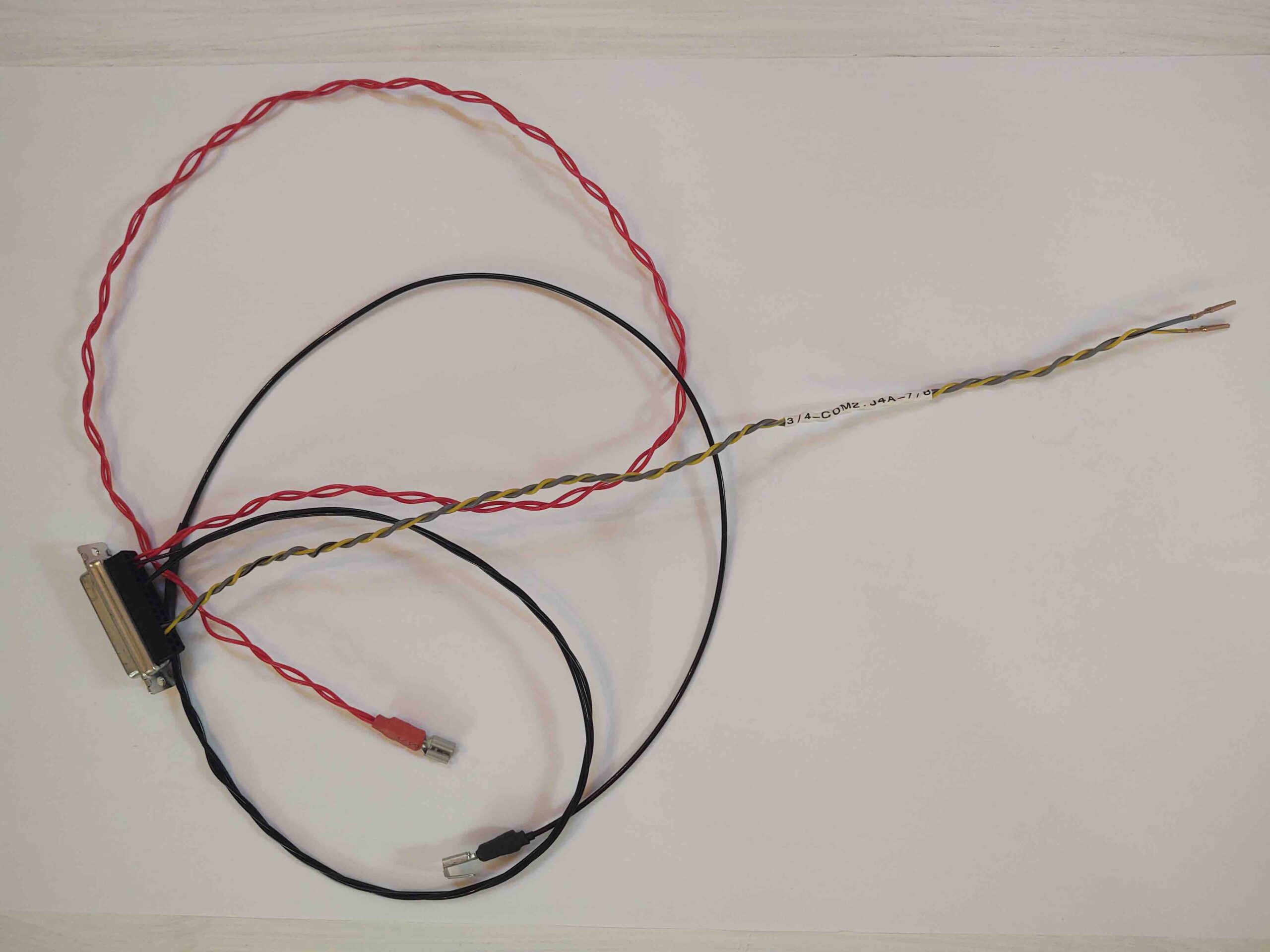
•••
27 October 2020 — For YEARS the plan has been to mount to the Radenna SkyRadar ADS-B In Receiver on the top of the NG30 cover. But as I was looking at the cover, then the space on top of the canard, I could see no reason why not just mount it on the canard and keep the NG30 cover nice and clean.
So that’s the new plan. And here is the new mounting location for the ADS-B receiver. I already checked that all the cables will reach it just fine.
•••
